Pound for pound, Singapore has to be one of the world’s best countries for food. It’s little more than half the size of Hong Kong but it’s home to one of the most delicious and diverse cuisines we’ve experienced anywhere in the world.
Food is an obsession in Singapore. It forms an important part of their national identity and is viewed as a unifying cultural thread. As you can probably tell from the plethora of hawker centres and Singapore food blogs, eating is a national pastime and a frequent topic of conversation among Singaporeans.
Being from the Philippines, Singapore is a frequent destination for us and much of that has to do with delicious Singaporean dishes like laksa, nasi lemak, char kway teow, kaya toast, and bak kut teh. And let’s not forget about chilli crab and Hainanese chicken rice, Singapore’s national dishes!
Simply put, this island is overflowing with amazing food. If you’re visiting Singapore and looking for the best dishes to eat, then I hope this Singapore food guide leads you to many shiok meals in the city.
SINGAPOREAN FOOD QUICK LINKS
To facilitate your Singapore trip planning, I’ve compiled links to hotels, tours, and other services here.
HOTELS
Top-rated hotels in Orchard, one of the best areas to stay for first-time visitors to Singapore.
- Luxury: Singapore Marriott Tang Plaza Hotel (SG Clean)
- Midrange: Holiday Inn Express Singapore Orchard Road (SG Clean), an IHG Hotel
- Budget: YOTEL Singapore Orchard Road (SG Clean, Staycation Approved)
TOURS
- Food Tours: Food and Drinking Tours in Singapore
- Cooking Classes: Cooking Classes in Singapore
OTHER SERVICES
- Visa Services
- Travel Insurance (with COVID cover)
- Airport Transfers
- Go City Pass (tourist discount card)
- Singapore eSIM
SINGAPORE TRAVEL GUIDE
If you’re planning your first visit to Singapore, then be sure to check out our detailed Singapore travel guide. It’ll have all the information you need – like when to go, which area to stay, which attractions to visit, etc. – to help you plan your trip.
Save This on Pinterest!
No time to read this article on the best food in Singapore? Click on the save button and pin it for later!
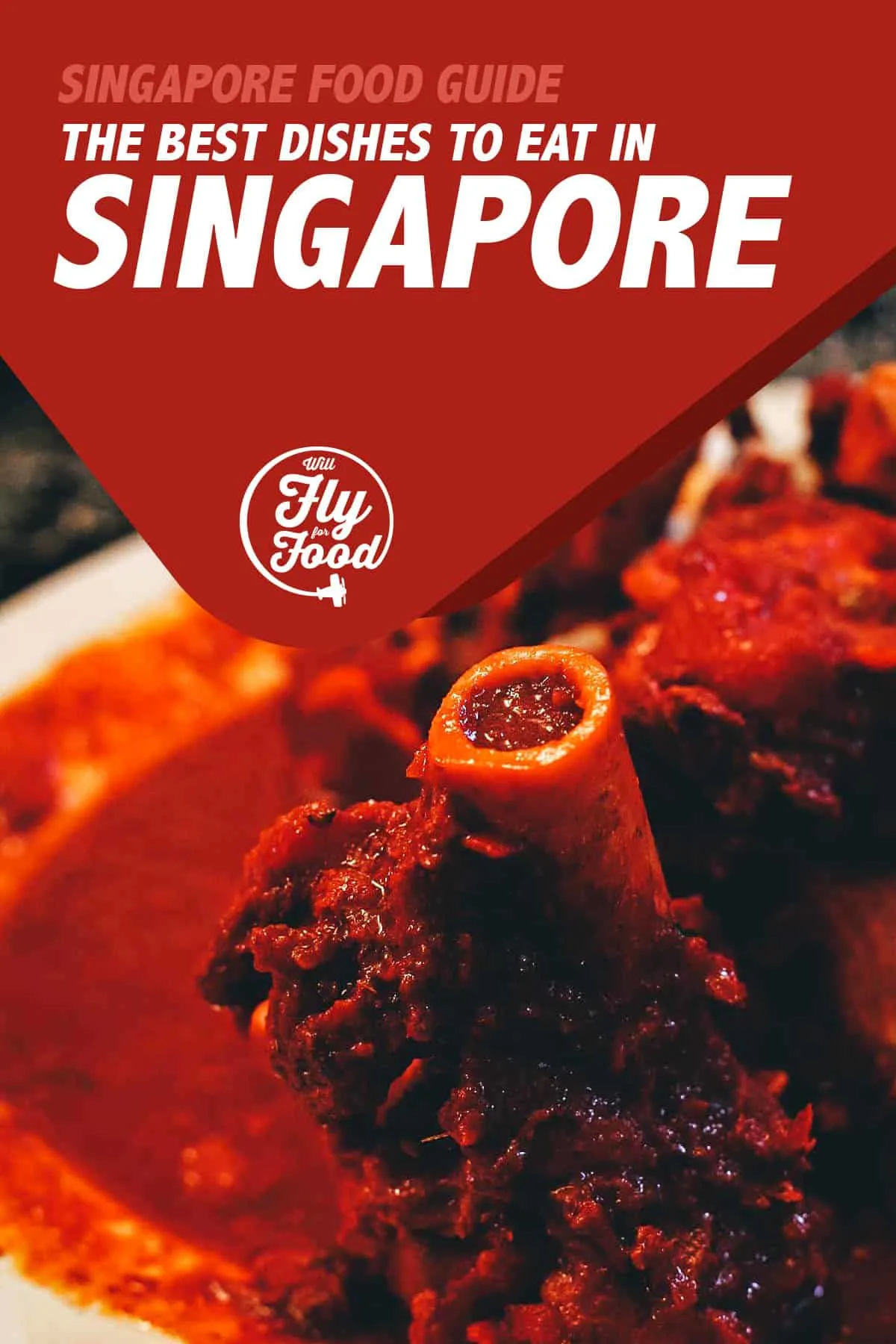
WHAT IS SINGAPOREAN FOOD?
Singaporean cuisine is characterized by its diversity. It’s a multiracial and multicultural country with a population consisting mainly of ethnic Chinese, Malays, and ethnic Indians.
Singapore’s geographic location – between the Pacific and Indian oceans – and its history as a former British colony helped lead to this confluence of cultures.
When Stamford Raffles sought to convert the island into a trading post for the British Empire in 1819, immigrants from China, the Malay Peninsula, India, Indonesia, Europe, the United States, and the Middle East flocked to Singapore. With them came their cultures and culinary traditions which led to Singapore’s food becoming the mixed cultural cuisine that it is today.
This culinary diversity is no better exemplified than at the many hawker centres and food courts found throughout Singapore. Walk into any of these hawker centres and it isn’t uncommon to find a food stall selling Chinese Singaporean food next to a stall selling Malaysian food next to a stall selling Indian food next to a stall selling Indonesian food.
This melting pot aspect of Singaporean cuisine is what I love most about this country. It truly is a food lover’s paradise.
MUST-TRY DISHES IN SINGAPORE
To help organize this Singapore food guide, I’ve broken the dishes down by category. Some dishes can fall under more than one category but I’ve done my best to make it as organized and easy to read as possible. Click on a link to jump to any section.
SINGAPOREAN BREAKFAST
1. Kaya Toast
Kaya toast refers to a traditional Singaporean breakfast dish. It consists of two slices of toast or charcoal-grilled bread spread over with butter and kaya, which is a jam made with coconut, eggs, and sugar.
Kaya toast is believed to have been invented by Hainanese immigrants as a kope tiam dish. Kope tiam refers to traditional coffee shops in Singapore. It’s served with either coffee or tea and two soft-boiled eggs drizzled with dark soy sauce and white pepper. To eat, the soft-boiled eggs are stirred into a sludge and used as a dip for the kaya toast.
Like nasi lemak, kaya toast is commonly eaten for breakfast though it’s often enjoyed as an afternoon snack as well. Available at many coffee shops throughout Singapore, it’s best eaten immediately upon serving when the toast is still warm and the butter cold.
RECIPE: Kaya toast
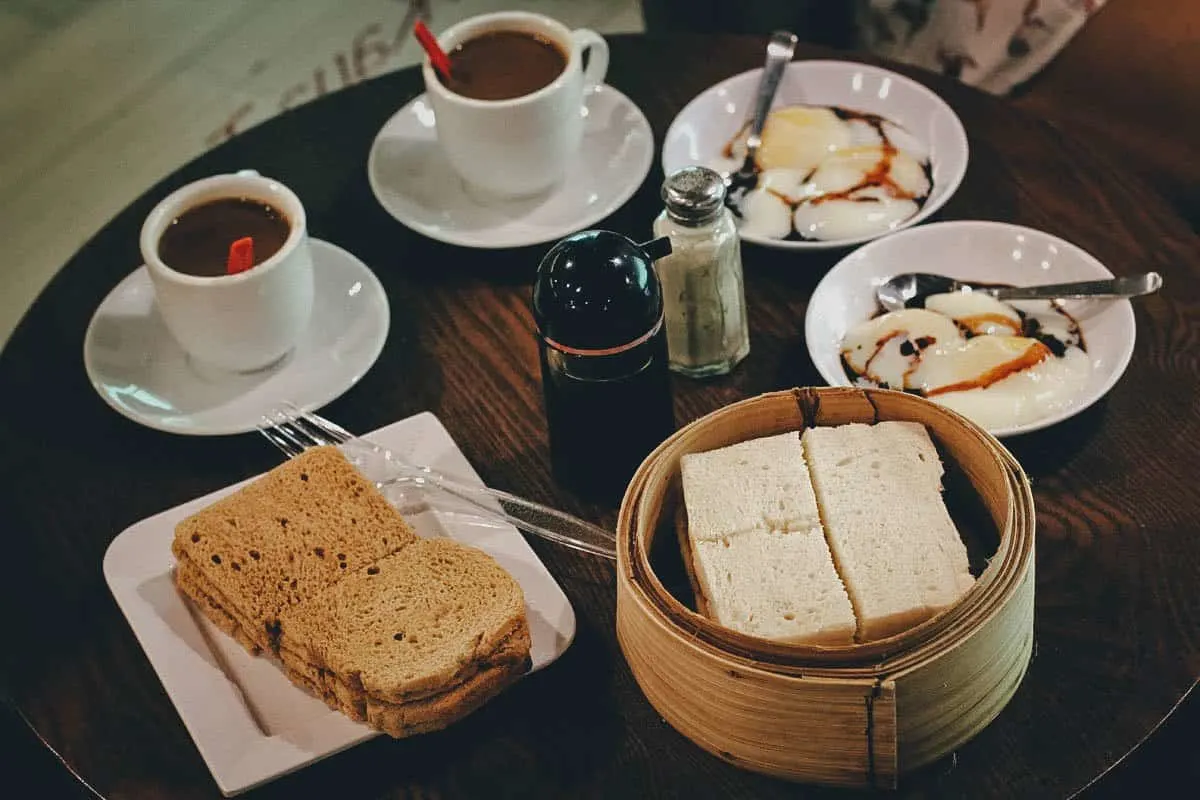
2. Tau Huay
Tau huay refers to a soft tofu dish popular in many Asian countries. It’s a dish of Chinese origin also referred to as douhua, tofu pudding, or bean curd.
Depending on where it’s from, it exists in varying forms though the Singaporean dish is usually served with a clear sweet syrup with or without toppings like gingko nuts or red beans. It can be served hot or cold with different syrups and varying levels of sweetness.
Bean curd is a popular Singaporean breakfast dish that’s often enjoyed with Portuguese egg tarts and/or youtiao (fried dough sticks).
RECIPE: Tau huay
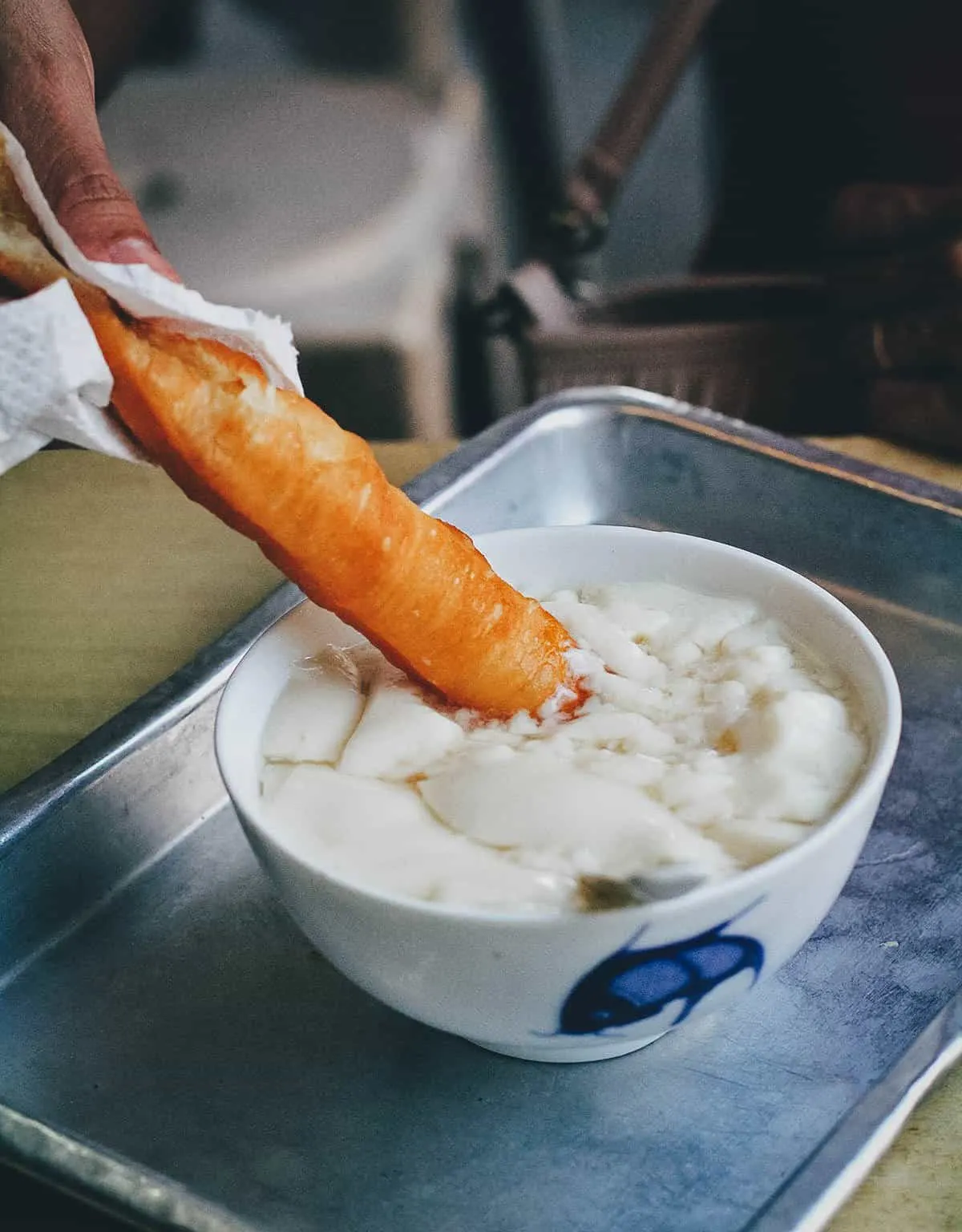
3. Roti Prata
Roti prata is an Indian-influenced flatbread dish found in many Southeast Asian countries. A common street food dish, it’s known as roti canai in Malaysia or parotta in South India.
To make roti prata, a wheat-flour-based dough is flipped and stretched into a large thin layer on a flat grilling pan. The edges are folded inwards to create multiple layers. The roti prata is cooked for about 3-5 minutes until it becomes lightly browned and crispy.
Roti prata can be eaten on its own though it’s often served with a vegetable- or meat-based curry dipping sauce. It can also be cooked with various ingredients like cheese, onions, chocolate, mushrooms, and eggs.
Common at hawker centres, roti prata is a popular breakfast food in Singapore though it can be enjoyed as a snack at any time of the day.
RECIPE: Roti prata
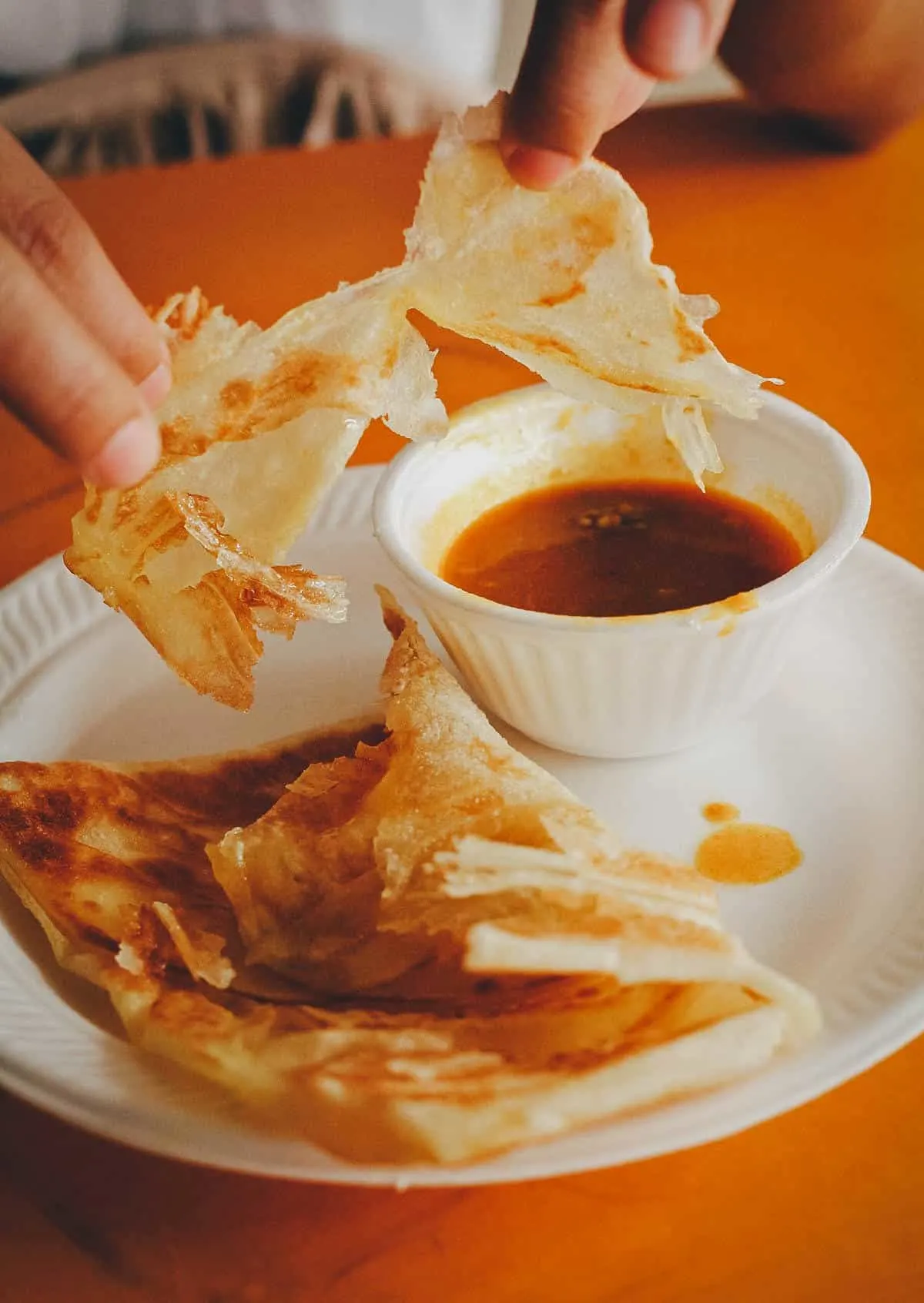
4. Murtabak
Murtabak is basically a stuffed version of roti prata. Commonly sold at hawker stalls and as street food, it’s popular in Southeast Asia and the Arabian Peninsula and can be filled with any number of sweet or savory ingredients.
In Singapore, murtabak is typically filled with spiced beef, chicken, or mutton and served with either a curry sauce, sweet pickled onions, or cucumbers in ketchup. A version filled with mozzarella cheese is also popular.
RECIPE: Murtabak
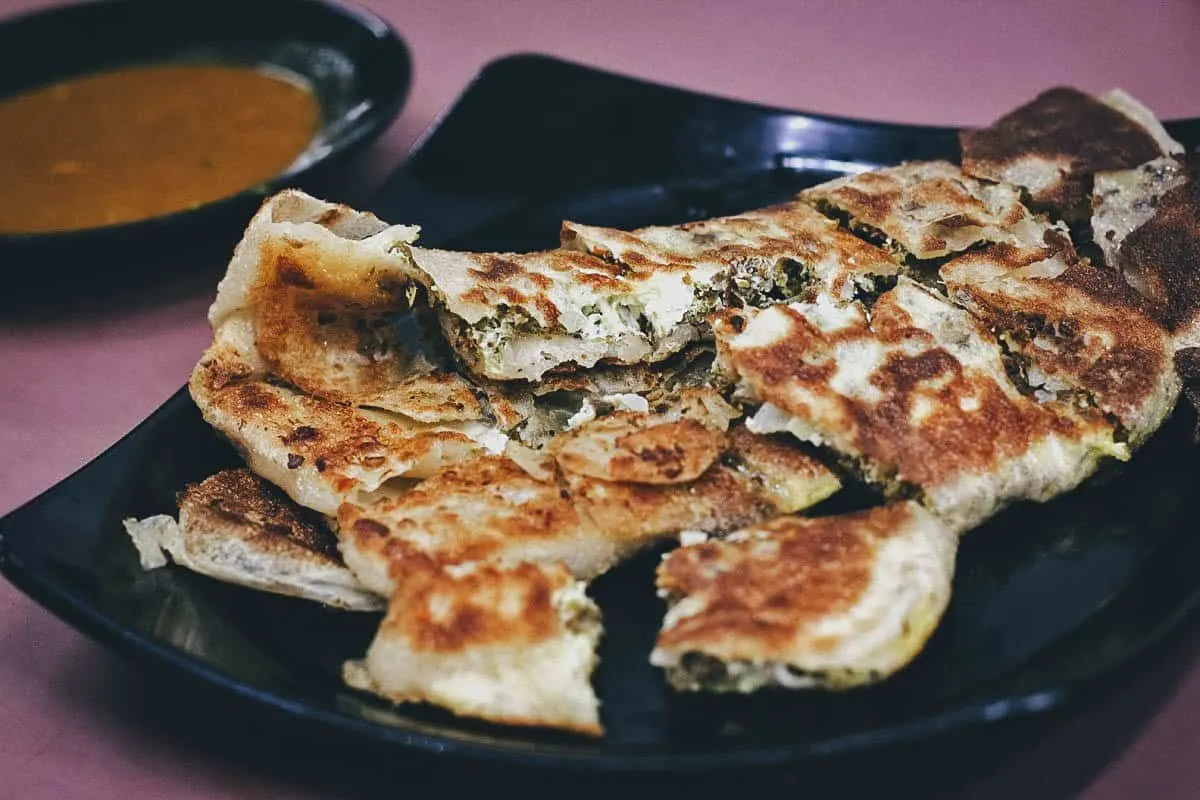
5. Appam
Appam or hoppers refers to a South Indian pancake dish that’s also widely consumed in Singapore. It’s made with fermented rice batter and coconut milk and can be served in both sweet and savory varieties.
Appam is a popular breakfast dish though it’s commonly enjoyed for dessert as well. It can be served plain or with various ingredients added as a topping. The plain appam I enjoyed below was served with a side of orange sugar and a cup of coconut milk.
If you try appam for breakfast, then you may want to have it with egg. A whole egg is cracked into the center of the pancake while it cooks so you’ll have a beautiful sunny-side up egg in the middle.
RECIPE: Appam
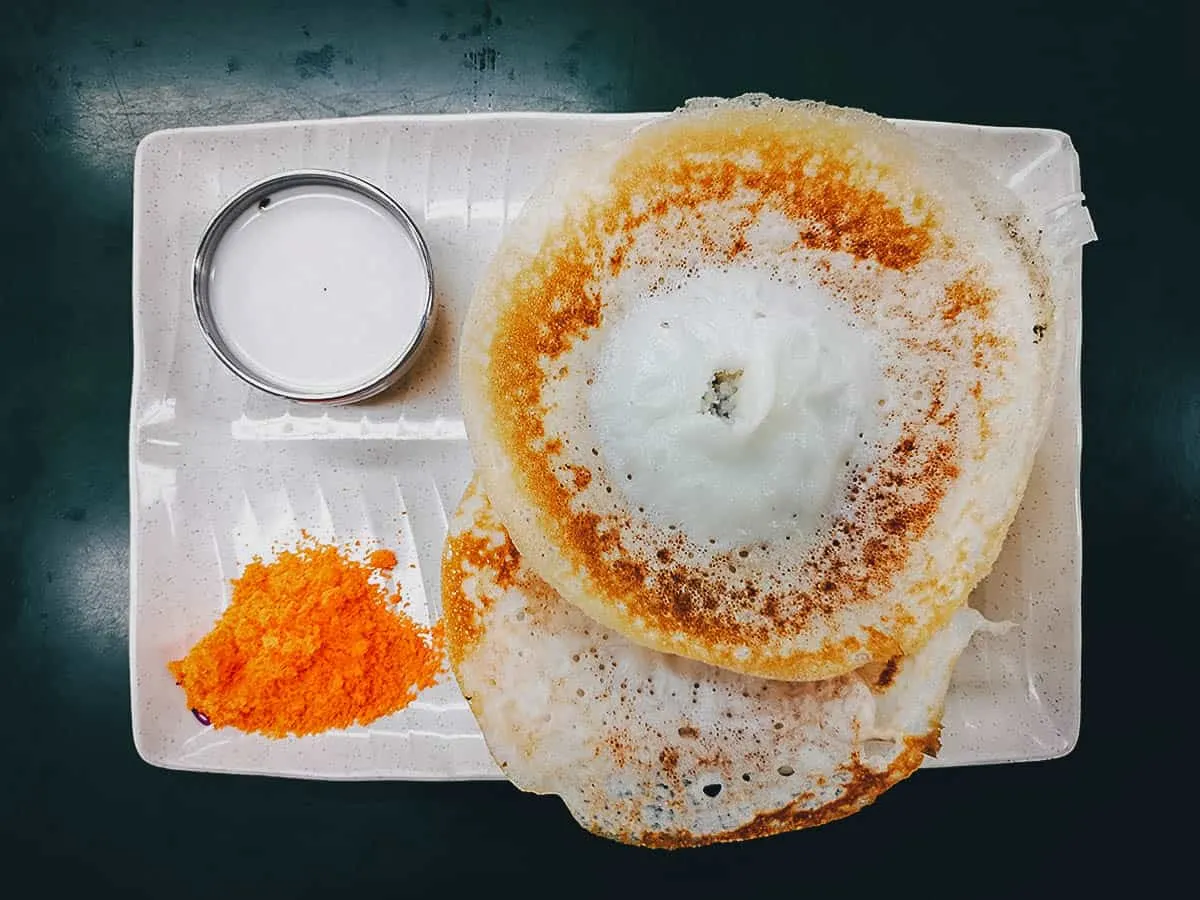
6. Congee
Congee refers to a rice porridge dish that’s popular in many Asian countries. Like nasi lemak, it’s a common breakfast food in Singapore though it’s the type of comforting dish that can be enjoyed at other times of the day as well.
Teochew or Singapore-style congee is typically served plain with a slew of Singapore side dishes like lor bak, steamed fish, salted egg, tofu, omelette, and vegetables.
RECIPE: Chicken congee
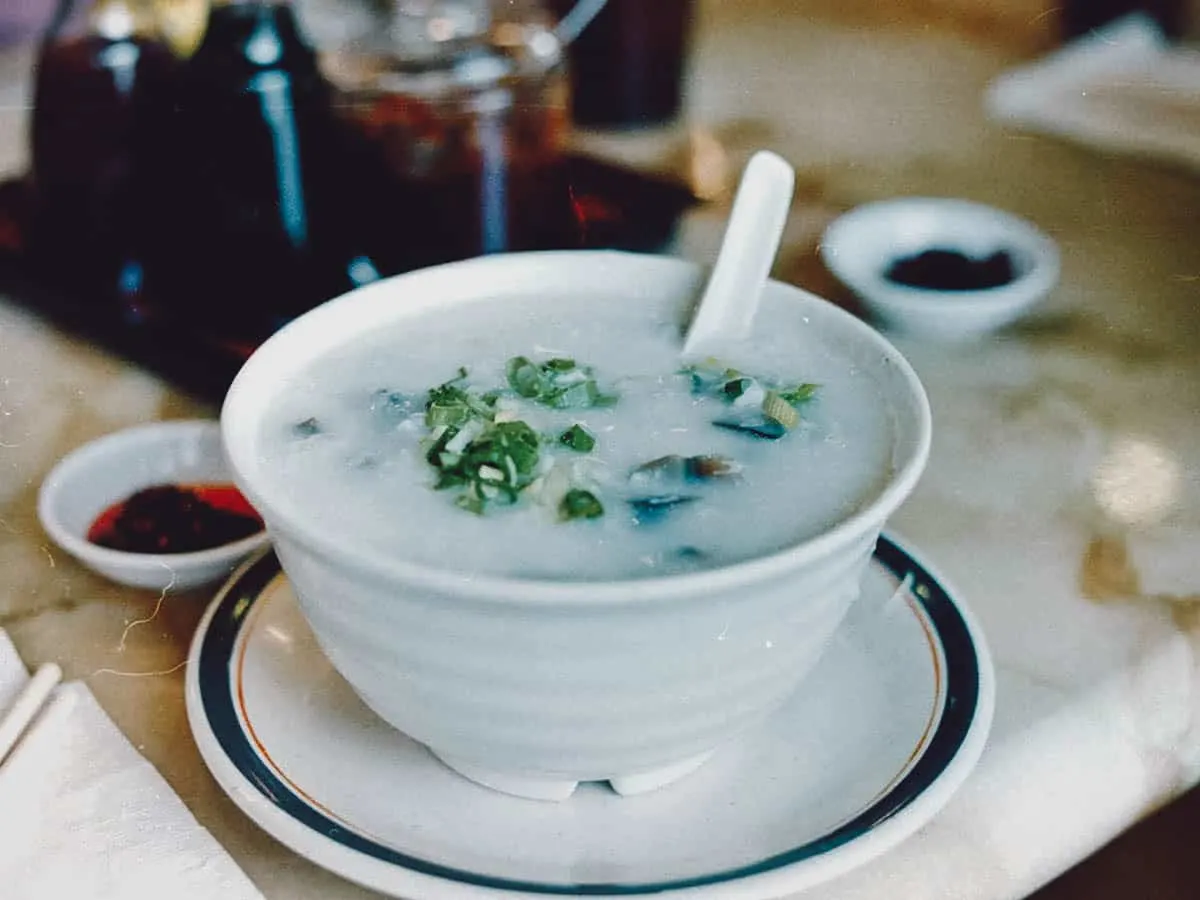
“Congee” by Travis Juntara, used under CC BY 2.0 / Processed in Photoshop and Lightroom
7. Chwee Kueh
Chwee kueh refers to a type of steamed rice cake topped with preserved radish. Like Singapore-style porridge, it’s a Teochew dish that’s popular in China and in other parts of Asia.
To prepare, a rice flour mixture is poured into small, saucer-like aluminum cups and then steamed. The rice cakes take the form of the cups when cooked and are served with diced preserved radish and a side of chilli sauce.
If you like strong Asian flavors, then you’re going to love chwee kueh. The steamed rice cake itself is mild in flavor but the preserved radish is what really makes this dish. It has a strong sweet/savory flavor that’s loaded with umami.
A popular hawker centre dish, chwee kueh is commonly eaten for breakfast in Singapore though personally, I prefer to enjoy it as a midday snack. It’s super tasty but I find its flavors to be too potent for breakfast.
RECIPE: Chwee kueh
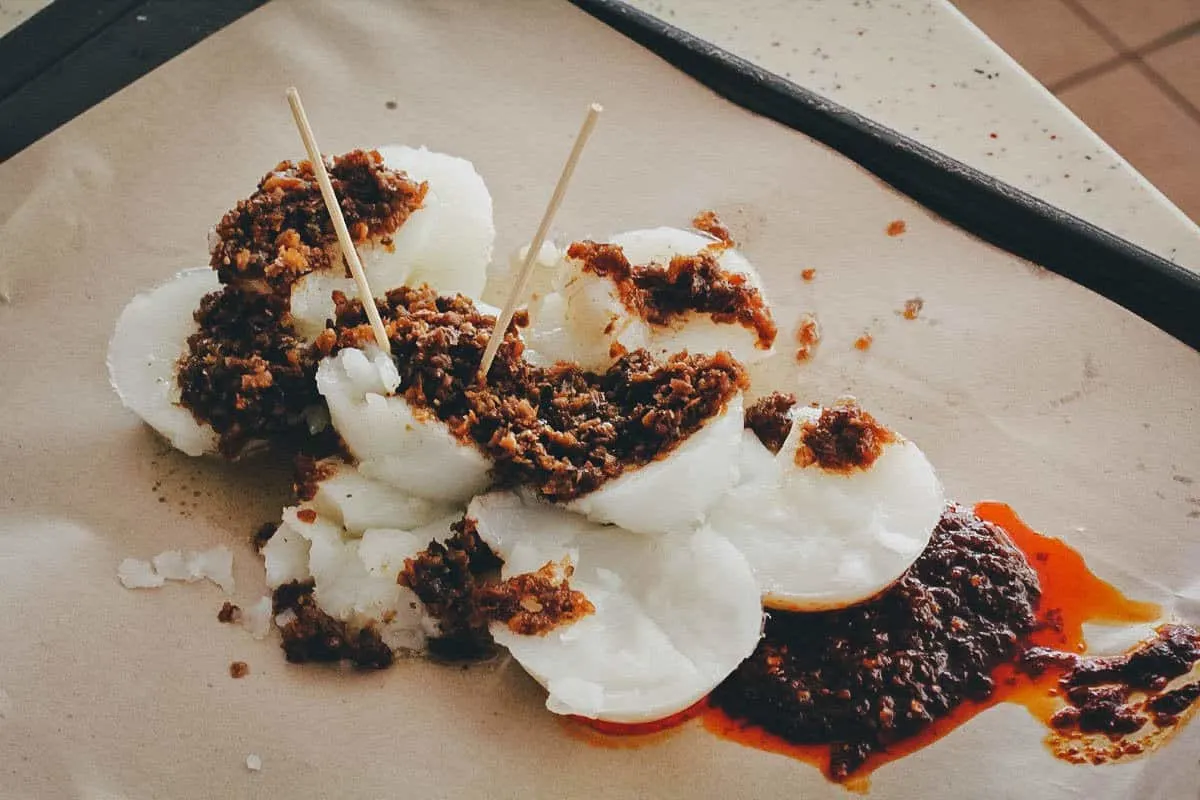
SINGAPOREAN SNACKS / SMALL MEALS
8. Curry Puffs
The curry puff refers to a small pie stuffed with various fillings in a deep-fried or baked pastry shell. It’s believed to be a snack of Malayan origin that was invented during the colonization area, mainly due to its similarities to pastries like the British Cornish pasty, the Portuguese empanada, and the Indian samosa.
A popular street food, they’re enjoyed in various forms but in Singapore, the most common types are made with a thick or flaky English-style crust with a variety of Chinese- and Indian-style fillings.
More traditional fillings include chicken curry, sardine, and tuna but more modern puffs can be filled with less conventional ingredients like durian, yam, corn, and red bean. Pictured below is a classic chicken curry puff with egg.
RECIPE: Curry puff
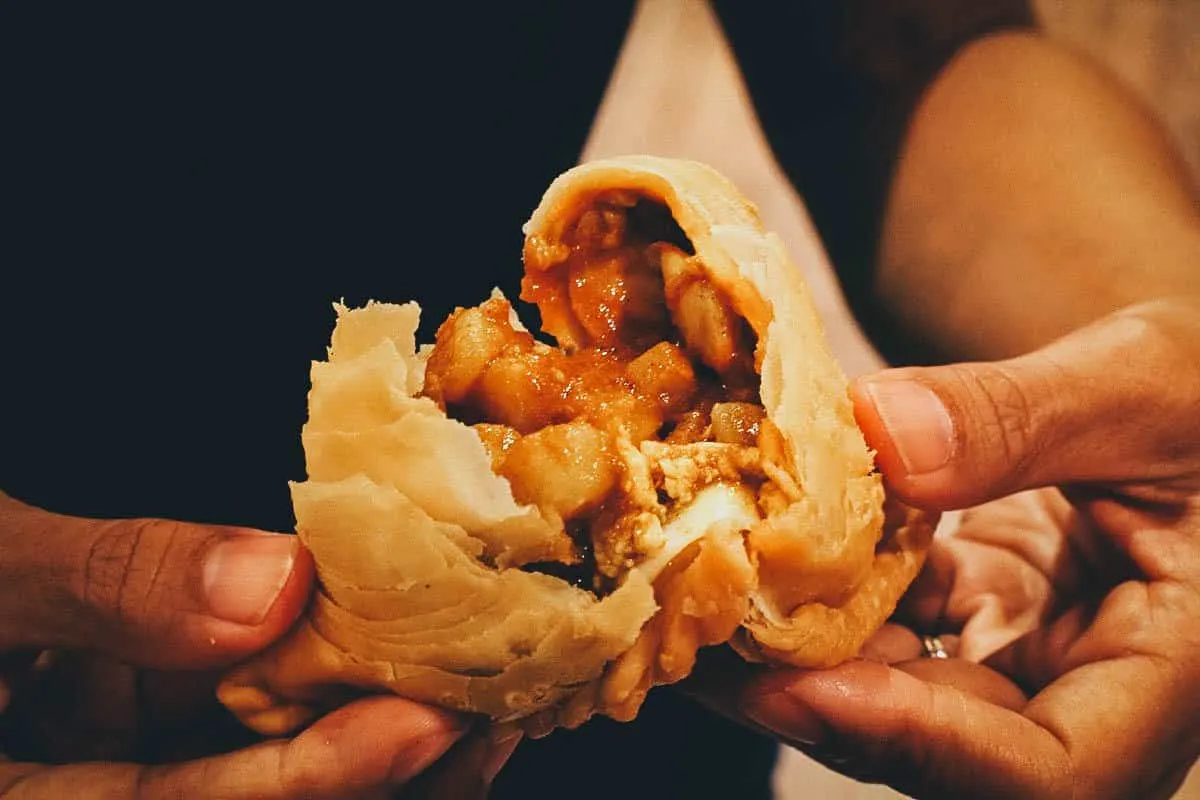
9. Popiah
Popiah refers to a Fujianese/Teochew-style fresh spring roll. It’s a dish of Chinese origin that’s become a popular street food dish in Taiwan and in many parts of Asia.
Popiah is made with a thin, pancake-like wrapper smeared with a sweet bean sauce and filled with a variety of ingredients like finely grated turnip, jicama, bean sprouts, and lettuce leaves. Depending on the individual vendor, it can be filled with other ingredients as well like fried tofu, crushed peanuts, shredded omelette, minced pork, shrimp, and crab.
RECIPE: Popiah
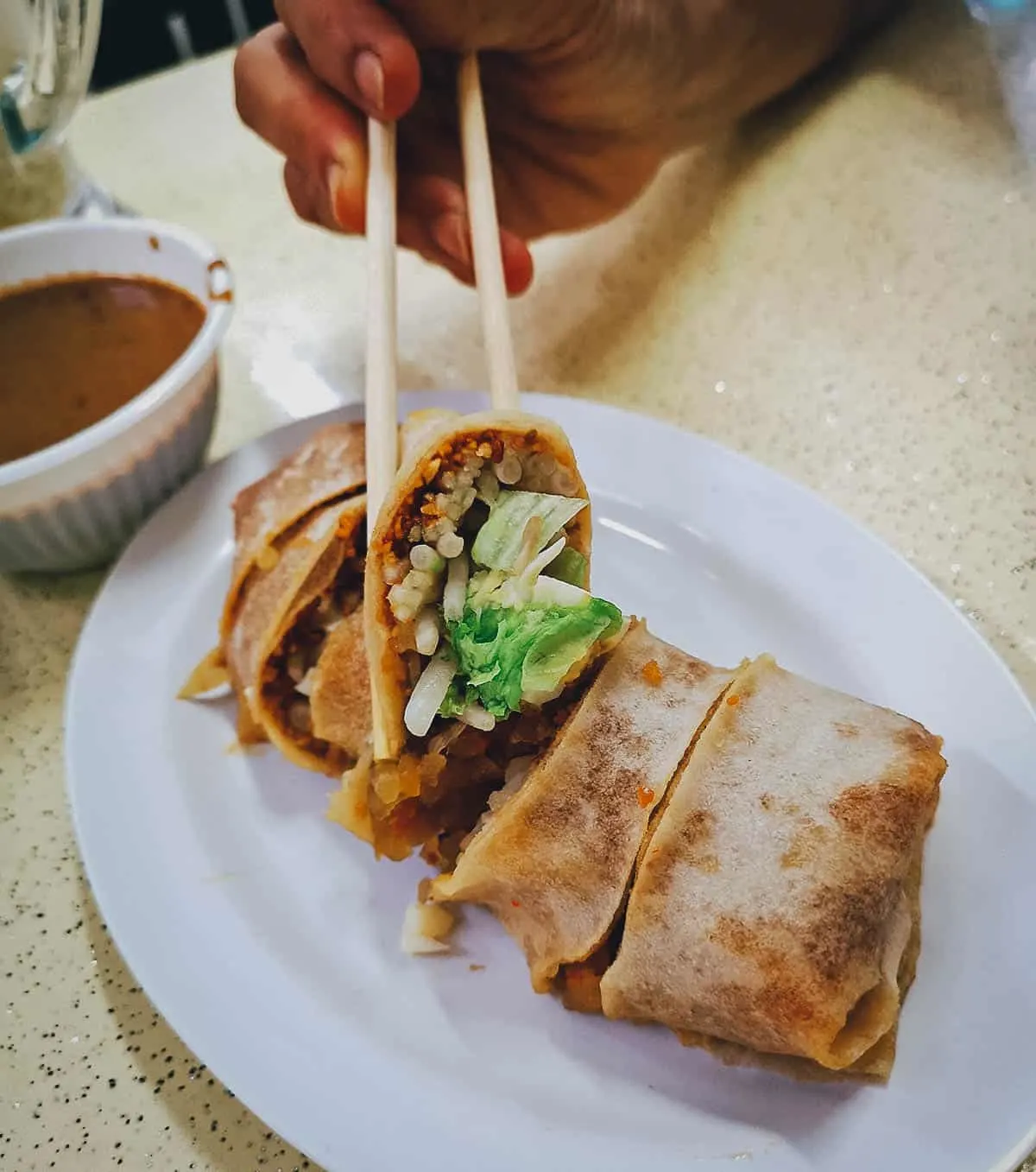
10. Rojak
Rojak is an Indonesian dish that’s become a popular food in Singapore and Malaysia. It’s basically a salad made with fresh fruits and vegetables.
To prepare, various ingredients like fresh cucumber, pineapple, and unripe mango and green apple are placed in a bowl and mixed with a thick brown sauce made with shrimp paste, tamarind, sugar, chili, and crushed peanuts.
It doesn’t look all that appetizing but it’s a refreshing and surprisingly delicious dish. It’s sweet, sour, savory, juicy, and crunchy with a good punch of umami from the shrimp paste.
Some westerners may find the combination of tangy unripe fruit and shrimp paste to be odd and off-putting but it’s actually a classic pairing in many Asian countries. It’s definitely one of the most interesting things you’ll eat in Singapore.
RECIPE: Rojak
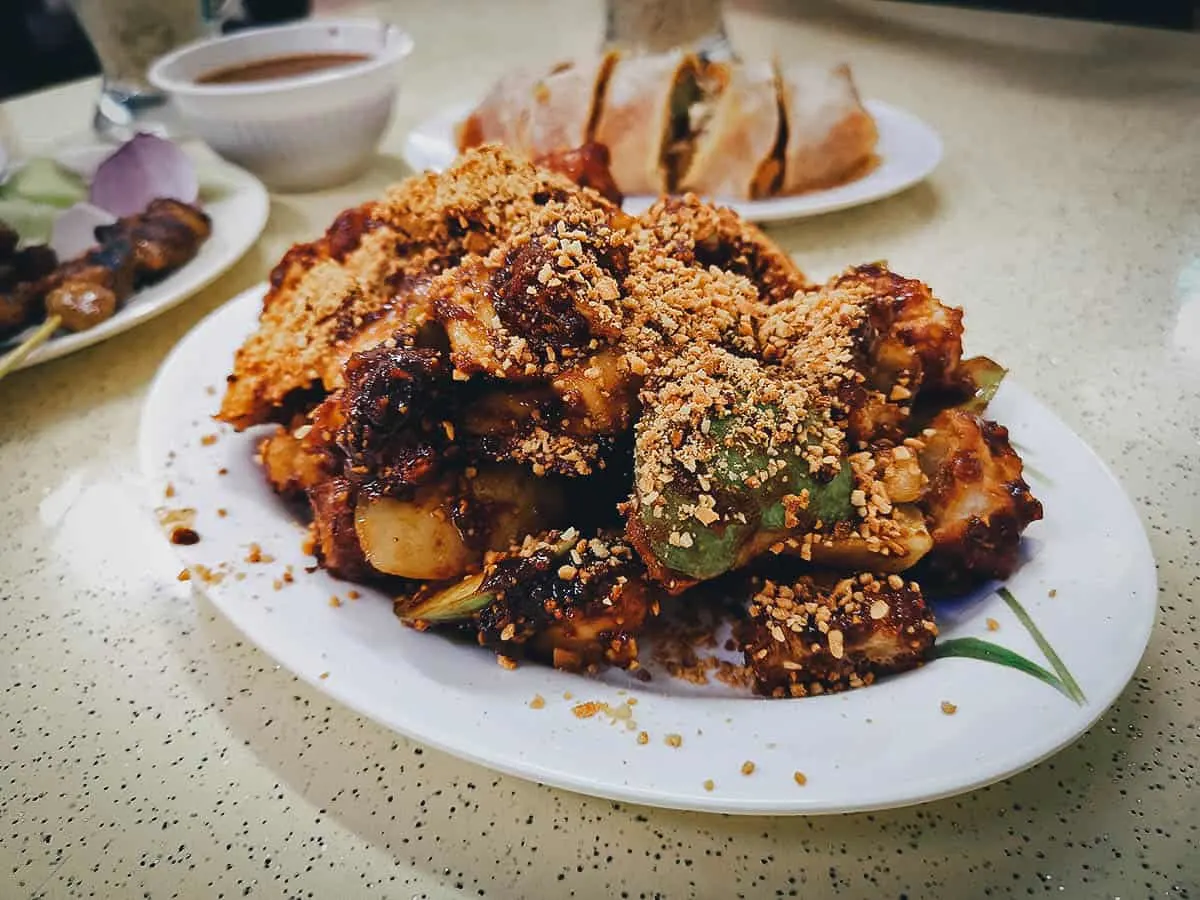
11. Satay
Satay or sate refers to a popular dish of seasoned and skewered grilled meat served with peanut sauce. Different types of meat like chicken, pork, mutton, or beef are skewered on bamboo sticks and grilled over a charcoal or wood fire.
Depending on the vendor, satay can be served with different sauces though the most common variety is made with soy and peanut sauce. In Singapore, peanut sauce is most common.
Satay is believed to have originated in Indonesia where it’s considered a national dish. Because of its popularity and universal appeal, it can be found pretty much anywhere from street food carts to hawker centers to proper sit-down restaurants in Singapore.
RECIPE: Chicken satay
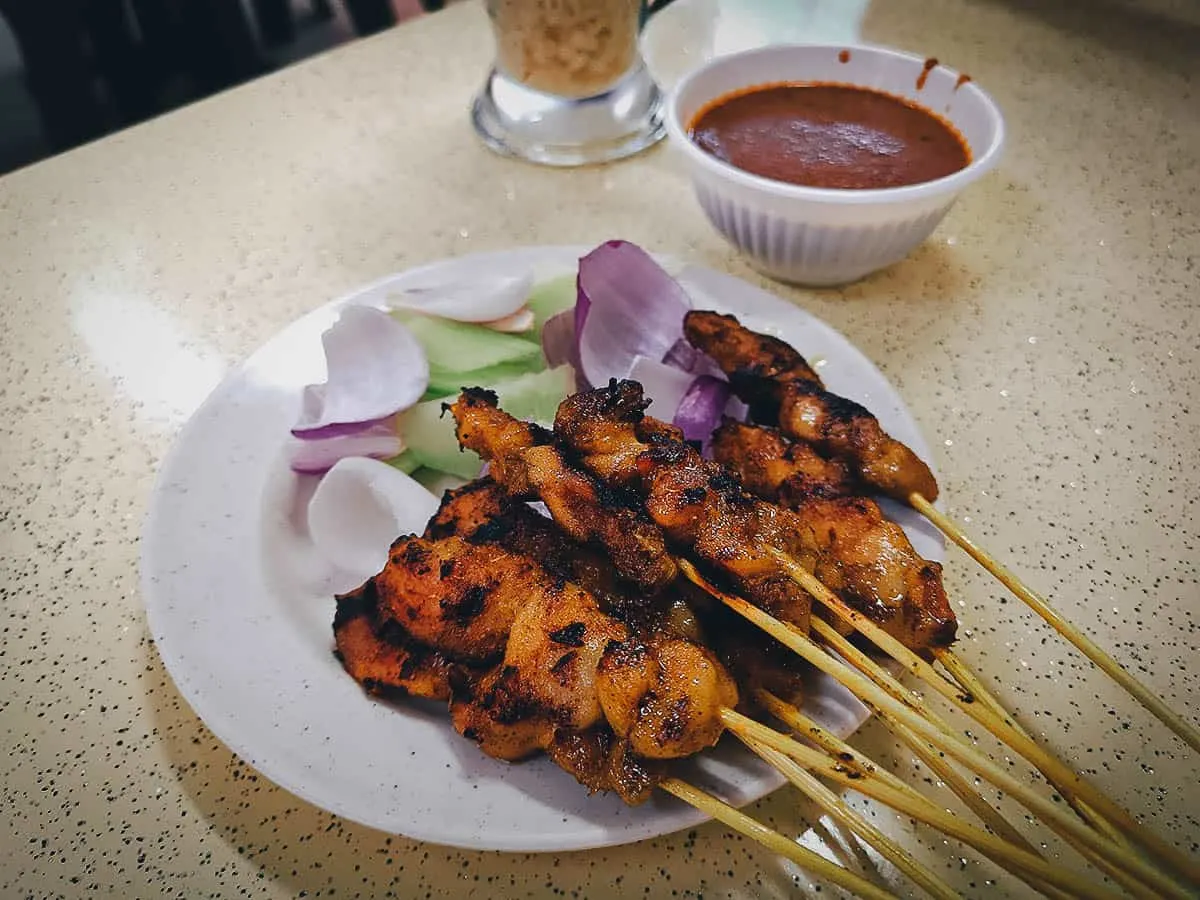
12. Orh Jian (Oyster Omelette)
Orh jian is a popular dish that you’ll find at many hawker centers in Singapore. It refers to an oyster omelette dish made with fresh raw oysters, tapioca starch, and eggs.
Oyster omelette is originaly a Hokkien or Teochew dish that’s become common in many parts of Asia. Often sold at hawker centres and street food carts, orh jian is known by many names like oh chien, or luak, or o-a-tsian.
To make oyster omelette, starch (typically sweet potato starch) is mixed into the egg batter to give the omelette a thicker, gooier texture. It’s fried till crispy and served with a side of chilli sauce.
RECIPE: Orh jian
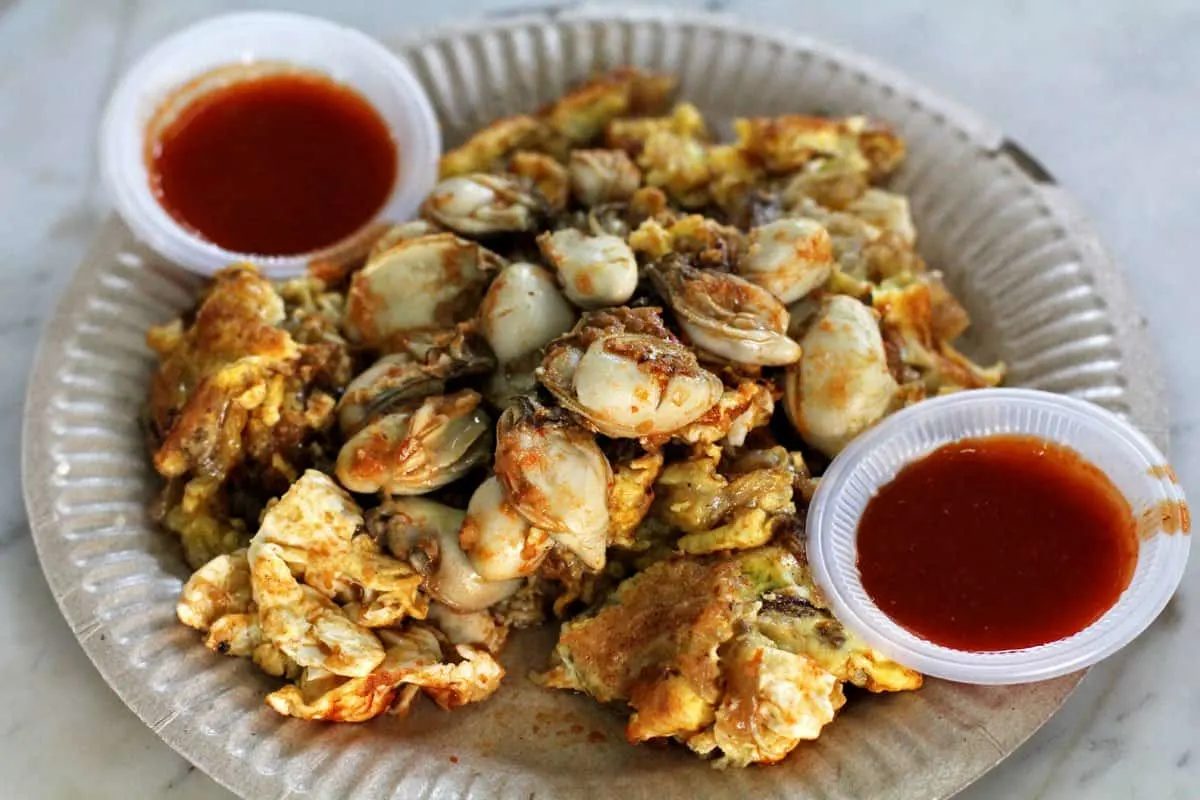
13. Chai Tow Kway (Carrot Cake)
Chai tow kway or “carrot cake” refers to another popular dish sold at many hawker centers in Singapore. It’s a dish of Teochew origin that’s made with radish cake stir-fried with eggs, preserved radish, and seasonings.
Oddly enough, chai tow kway is commonly known as carrot cake even though it isn’t made with any carrots. It doesn’t have any connection to western carrot cake either. Instead, it’s referred to as carrot cake because the words “chai tow” can mean either “radish” or “carrot”.
Chai tow kway is prepared in different ways but in Singapore, it’s typically cut into pieces and stir fried with eggs, garlic, and spring onion. It comes in white or black versions.
The black version gets its color from a sweet dark soy sauce. The white version isn’t made with this sauce so it tastes saltier and is cooked more like an omelette.
RECIPE: Chai tow kway
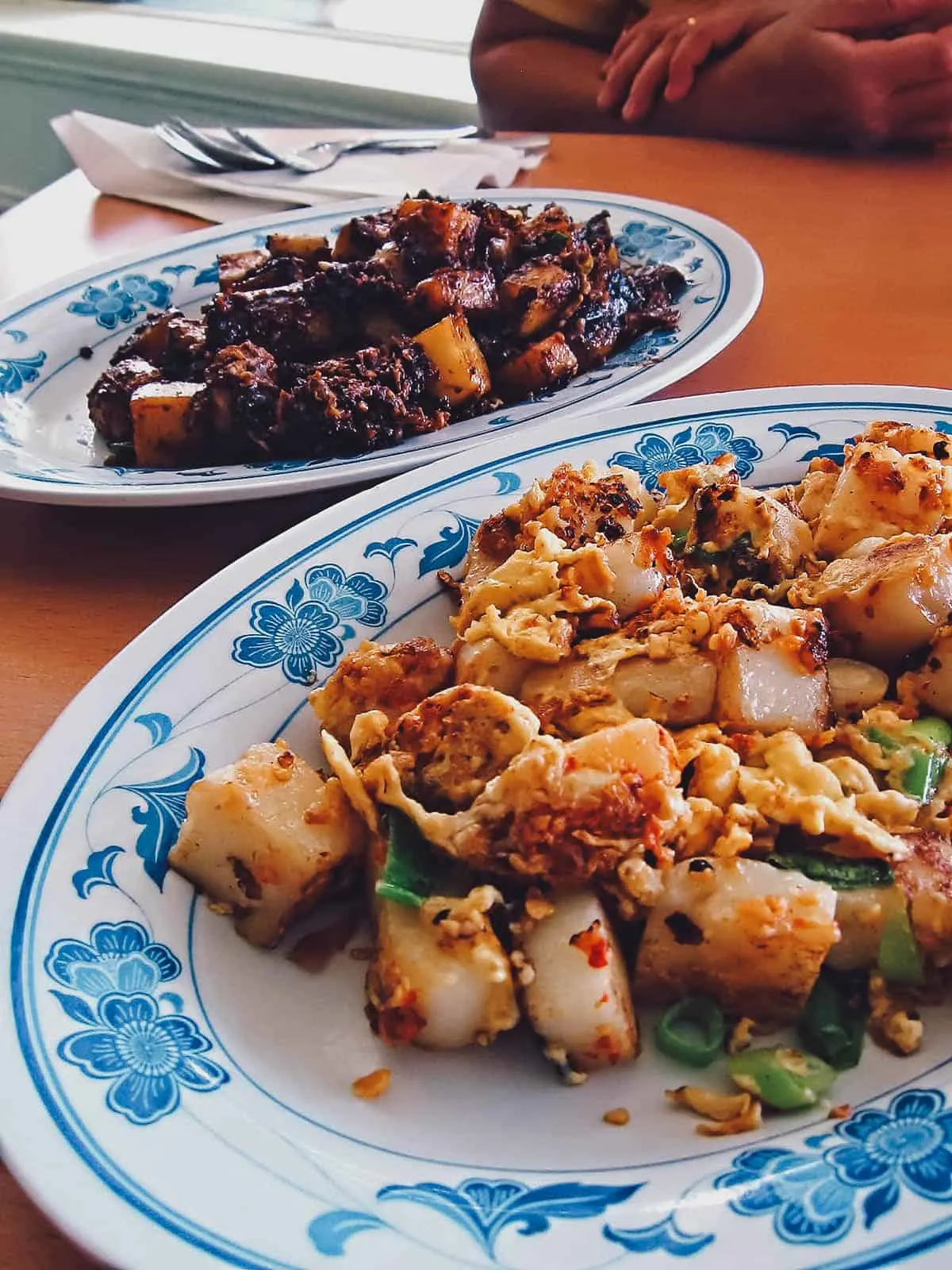
“Chai tow kway” by Ruth Ellison, used under CC BY 2.0 / Processed in Photoshop and Lightroom
14. Yong Tau Foo
Yong tau foo is a Hakka dish popular in Singapore and in other Asian countries with large Hakka, Teochew and Hokkien populations.
Traditionally, it consists primarily of tofu filled with a ground meat mixture or fish paste. It can be eaten dry with a sauce or served as a soup dish.
But in Singapore, it refers to a dish that can contain any number of ingredients like stuffed tofu, fish balls, fish cake, bitter melon, okra, cuttlefish, and other types of vegetables, meat, and seafood.
After cooking the ingredients briefly in broth, they can be served in a soup or offered dry with the broth served in a separate bowl. It can be eaten on its own or enjoyed with a bowl of steamed rice, noodles, or rice vermicelli.
RECIPE: Yong tau foo
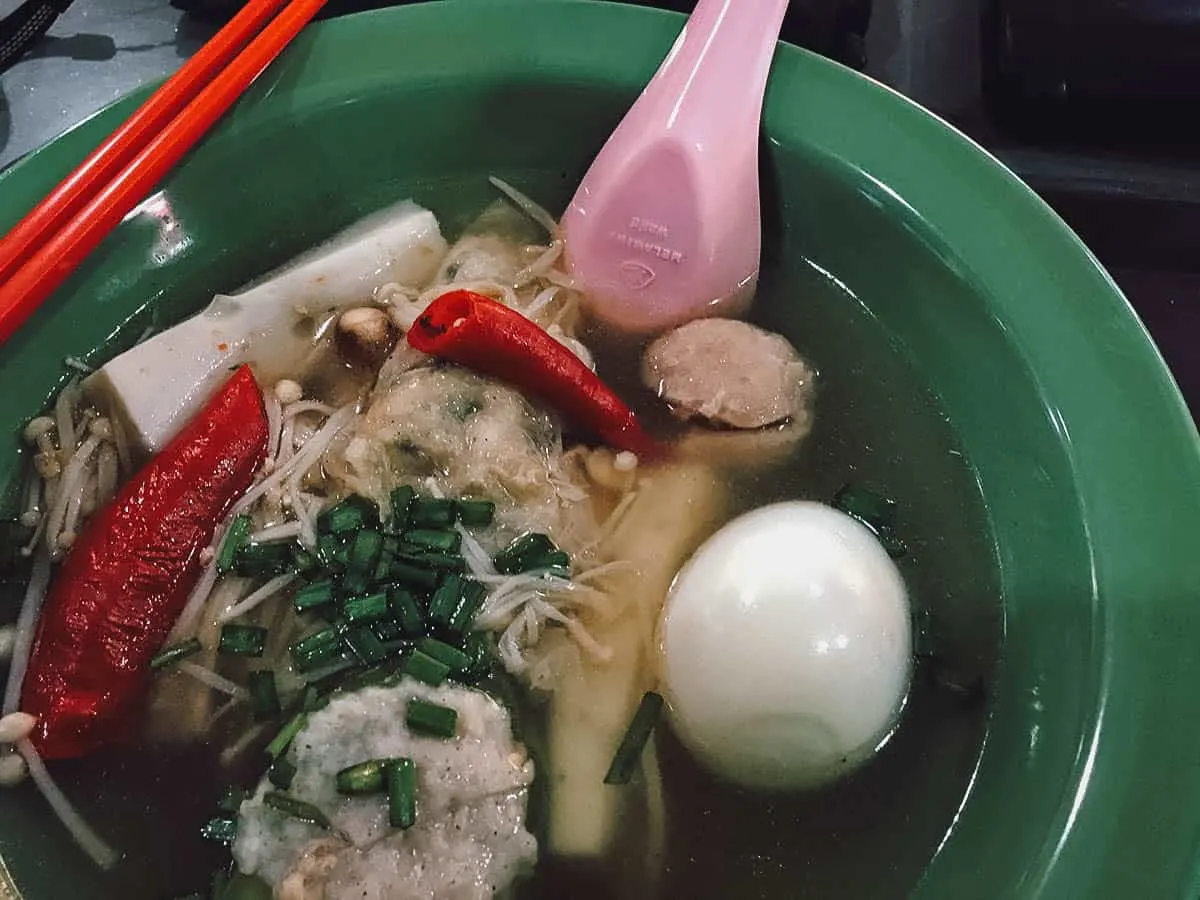
“People’s Park Yong Tau Foo” by Kars Alfrink, used under CC BY 2.0 / Processed in Photoshop and Lightroom
SINGAPOREAN MEAT / SEAFOOD DISHES
15. Bak Kut Teh
Bak kut teh refers to a Teochew pork rib soup cooked in a complex broth of different herbs and spices. Pork rib soup is a signature dish in Singapore that’s also popular in Malaysia and in parts of Indonesia and southern Thailand.
The name bak kut teh literally translates to “meat bone tea” though no tea is actually used to make this dish. The name is in reference to a strong oolong Chinese tea that’s usually served with the soup to help dissolve the fat from the pork ribs.
To make bak kut teh, meaty pork ribs are simmered for hours in a broth of herbs and spices that include garlic, cinnamon, star anise, cloves, dang gui (Chinese angelica root), and fennel seeds. Depending on the cook, other ingredients may be added to the bak kut teh like offal, mushroom, Chinese cabbage, and tofu.
Available at almost any hawker food centre, bak kut teh is usually eaten for breakfast or lunch with a bowl of steamed rice or youtiao and a dark soy sauce dip with chopped red chilis.
RECIPE: Bak kut teh
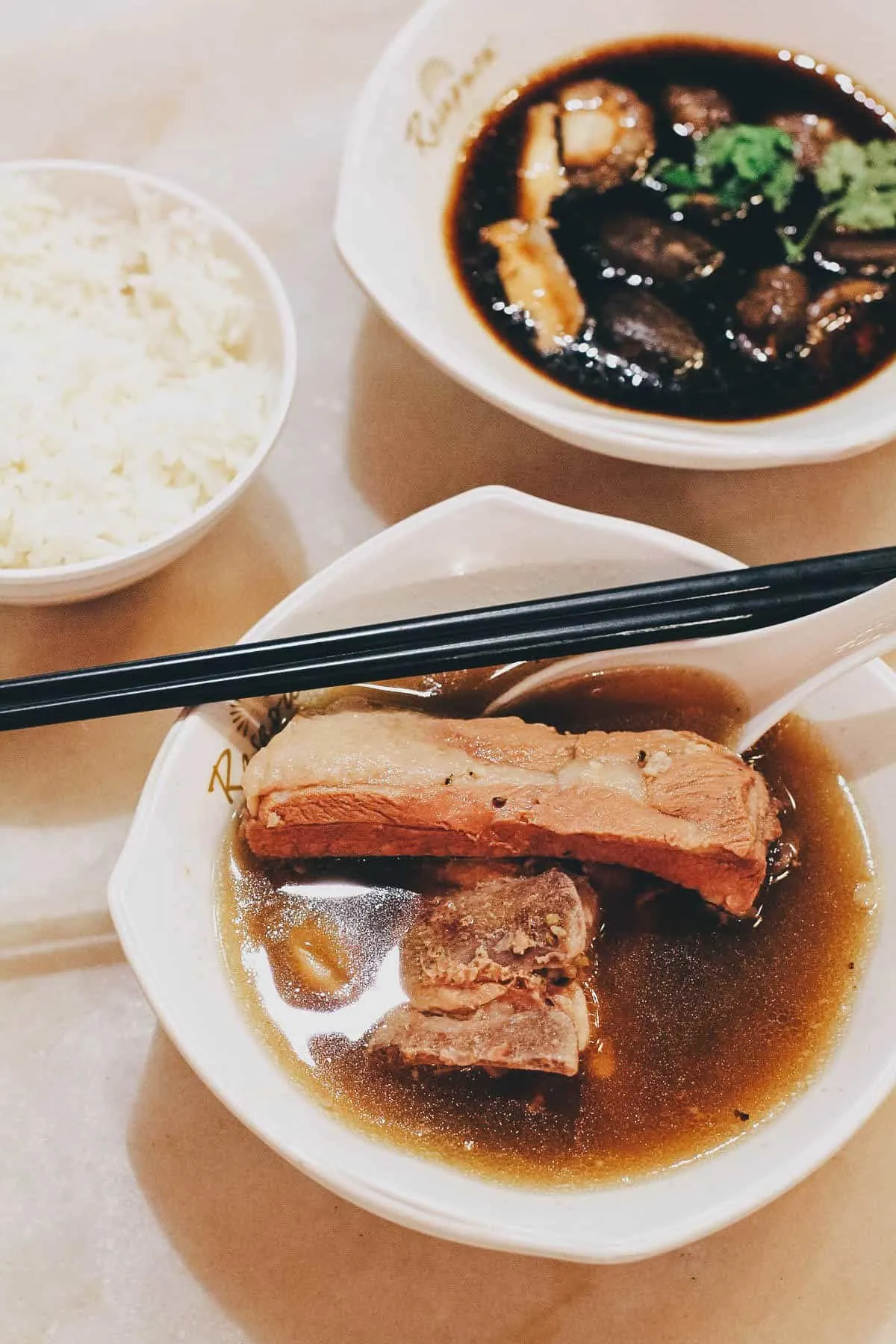
16. Sup Tulang
Sup tulang refers to a devilishly delicious dish made with mutton or beef bones stewed in tomato paste, chili, and spices. It’s considered a true Singaporean dish, created and popularized by an Indian Muslim food stall along Jalan Sultan in the 1950s.
In spite of its appearance, sup tulang isn’t very spicy at all. It’s more savory-sweet than spicy and is served with soft bread to mop up the sauce. The bread with the sauce is heavenly.
Just be warned, this dish is incredibly delicious but it’s also incredibly messy. It’s impossible to slice off the meat and tendon with utensils so you’ll need to hold the bones in your hands and gnaw at them with your teeth.
Be sure to have a fresh packet of napkins ready cause you’ll need them to wipe the tomato sauce off your hands, face, hair, shirt, pants, and shoelaces. It’s one of the messiest and tastiest dishes you’ll eat in Singapore.
RECIPE: Sup tulang
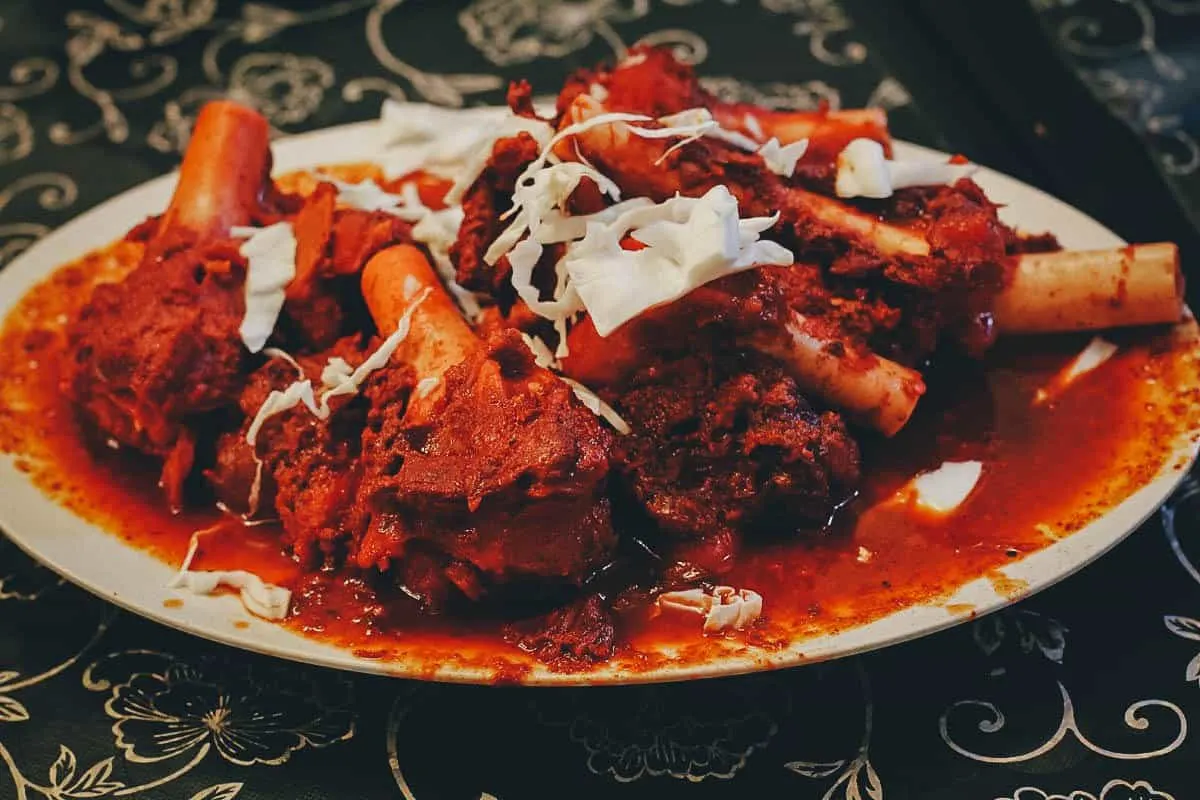
As you can probably tell from the picture above, there isn’t much meat on the bones. The real star of this Singaporean dish is the marrow which you’re meant to suck out of the bones with straws. My god was this good.
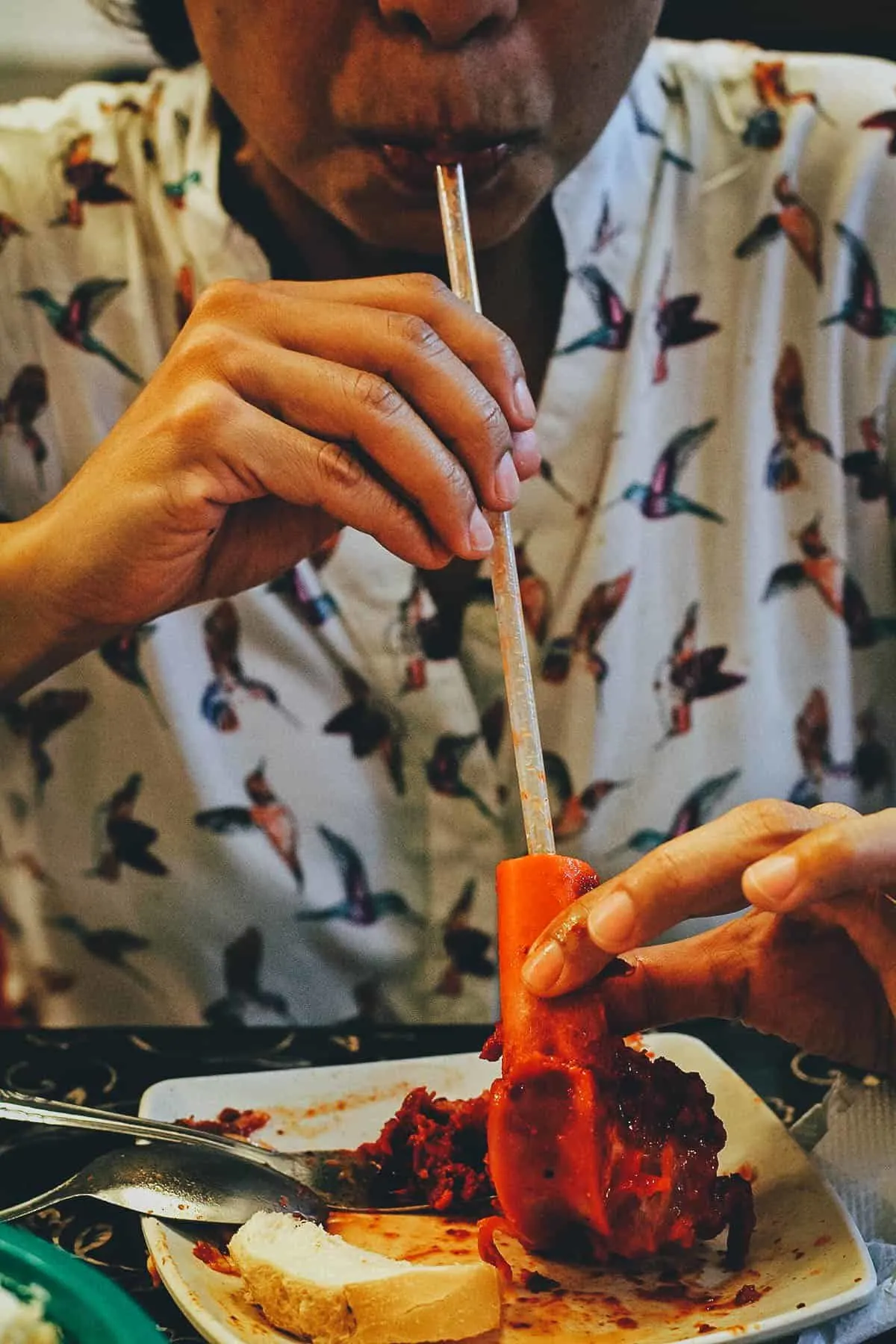
17. Chili Crab
If you were to eat just one dish in Singapore, then it should probably be chilli crab. It’s a vital part of the local food culture and considered by many to be the single most important dish in Singaporean cuisine.
Chilli crab is prepared by stir-frying crabs — commonly mud crabs — in a thick, tomato- and chili-based sauce. Egg is often added to make the sauce thicker and richer.
In spite of its name, chili crabs aren’t very spicy at all. They taste sweet and tangy with just a hint of spiciness.
RECIPE: Chili crab
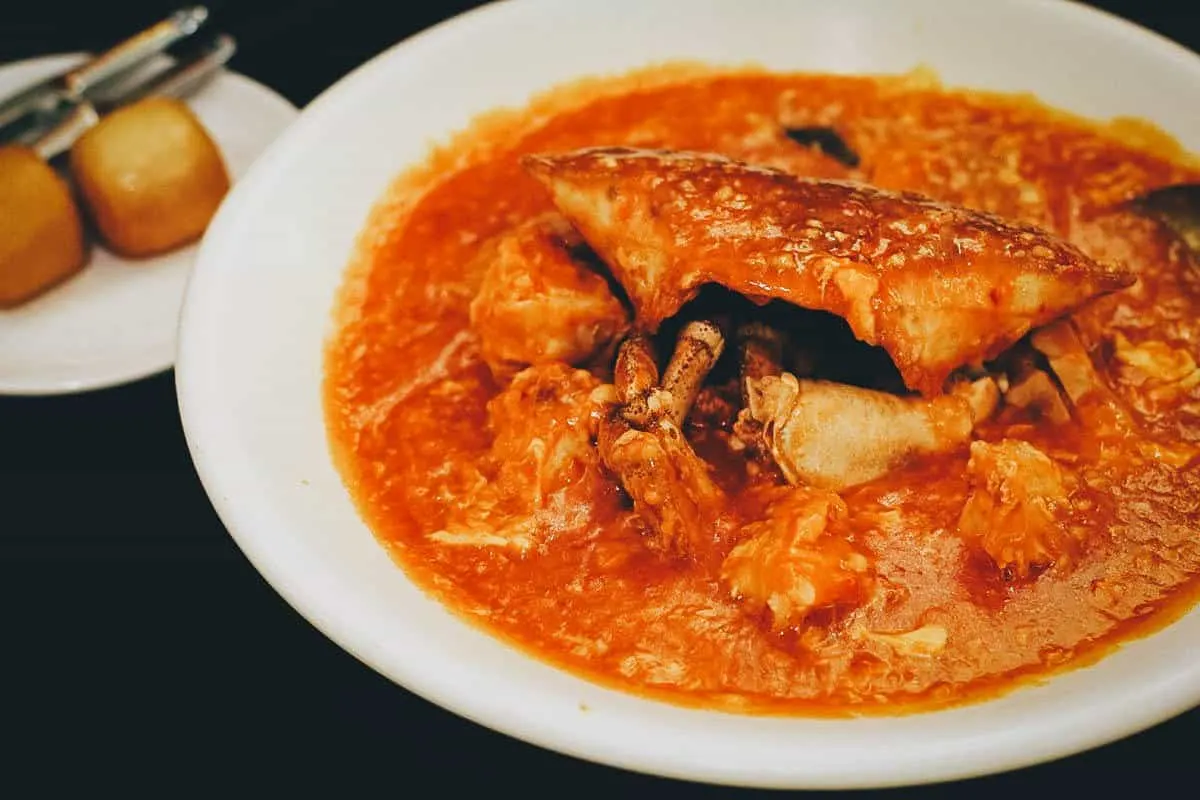
Chilli crab is best eaten with fried mantou bread to mop up the sauce. The fluffiness of the mantou with the sweet tanginess of the chilli sauce is a perfect match. The sauce is flavorful and nuanced so be sure to try it with some steamed rice as well.
Singaporeans are extremely proud of their chili crab. Like Hainanese chicken rice, it’s widely considered to be a national dish. In 2011, CNN Go included chili crab in their list of the “world’s 50 most delicious foods”.
If you’re looking for a special local meal in Singapore, one that goes beyond your average food centre dish, then it should definitely be chili crab. It’s a fabulous dish and one of the best things you’ll eat in Singapore.
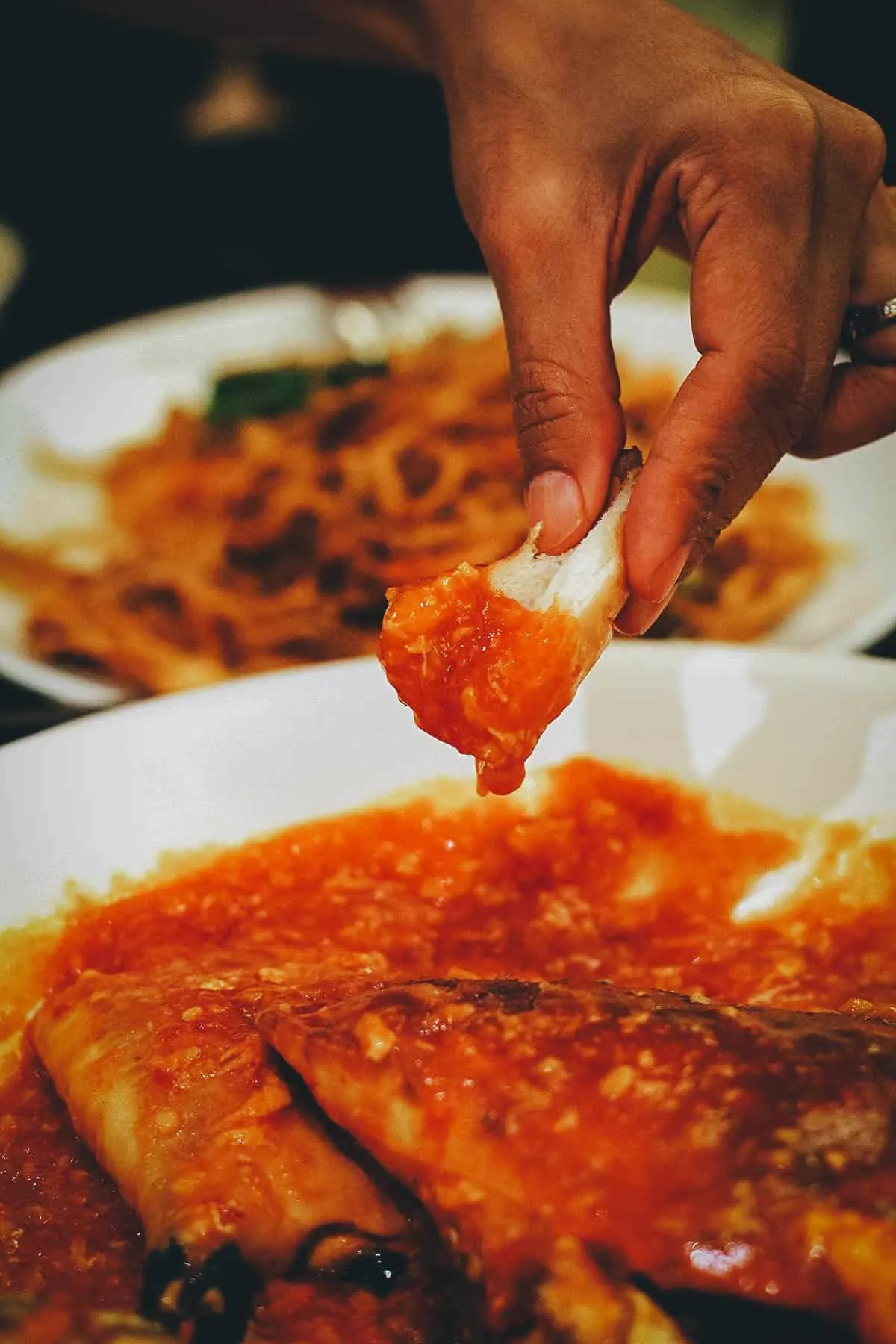
18. Fish Head Curry
As its name suggests, fish head curry refers to a dish made with a whole fish head – typically red snapper – stewed in a Kerala-style curry with assorted vegetables like eggplant and okra and over a dozen spices. It has mixed South Indian and Chinese origins and is a popular dish in Indonesian, Malaysian, and Singaporean cuisines.
RECIPE: Fish head curry
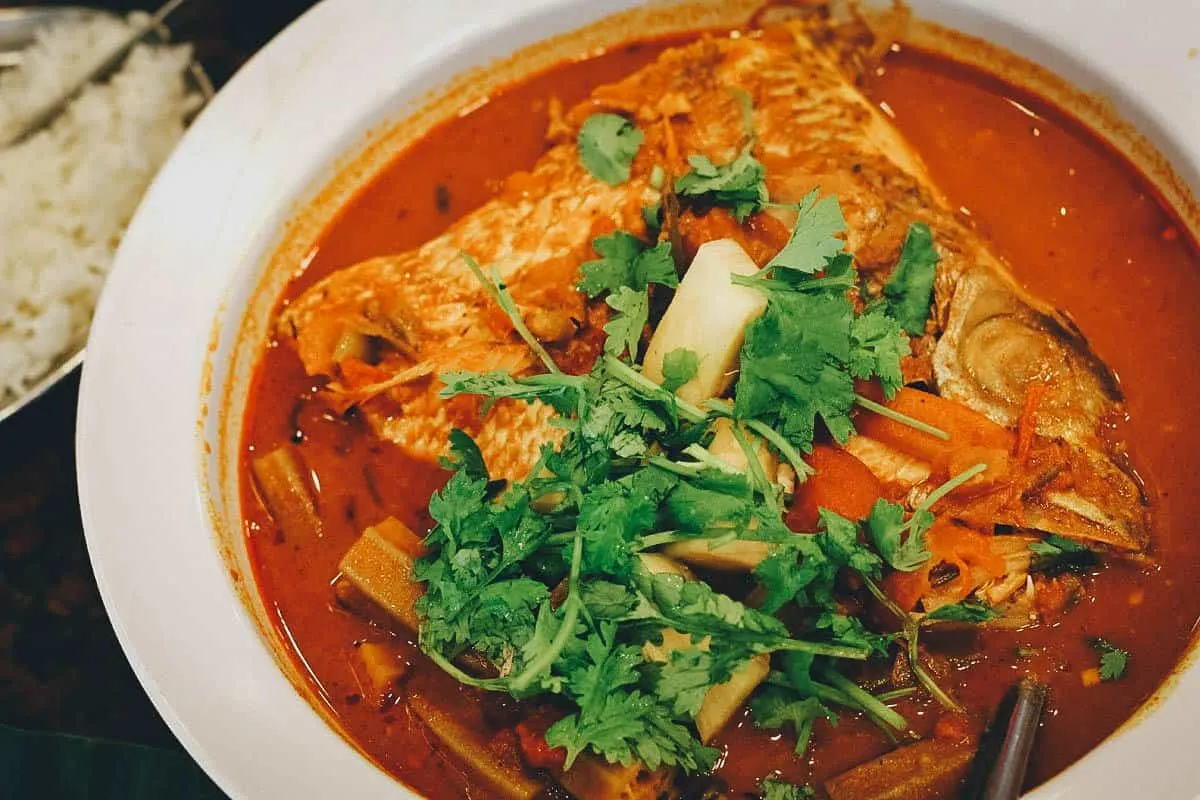
The gravy has a sour-sweet flavor that goes very well with rice and/or naan bread. The entire fish head was excellent but the best parts for me, are the eyeballs (pictured below), jaw, and tongue.
We enjoyed this fish head curry at the legendary Banana Leaf Apolo along Race Course Road. As their name suggests, you’ll eat your curry on a large banana leaf instead of plates. Banana Leaf Apolo is considered by many to be one of the best restaurants in Singapore for fish head curry.
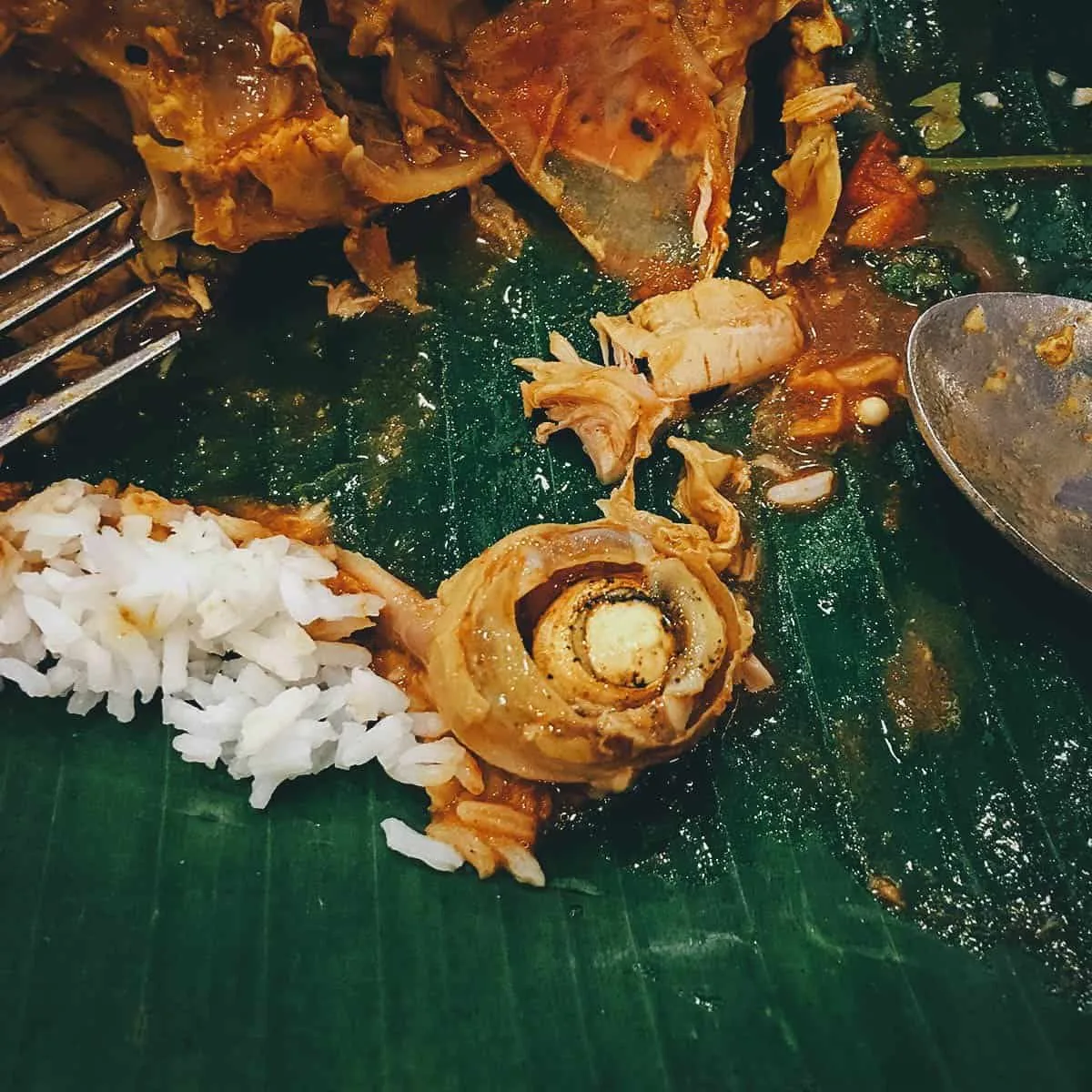
19. Sambal Stingray
Sambal stingray refers to a Malaysian/Singaporean dish of barbecued stingray served with a spicy sambal paste. It’s a popular hawker food in Singapore that’s cooked and wrapped in banana leaves.
Stingray has a firm, meaty texture that’s different from other fish. To cook, a sambal paste made up of various spices, Indian walnuts, and shallots is spread over the stingray before it’s wrapped in banana leaves and then charcoal-grilled.
Personally, stingray with sambal is one of my favorite dishes to eat with beer. It’s spicy and delicious.
RECIPE: Sambal stingray
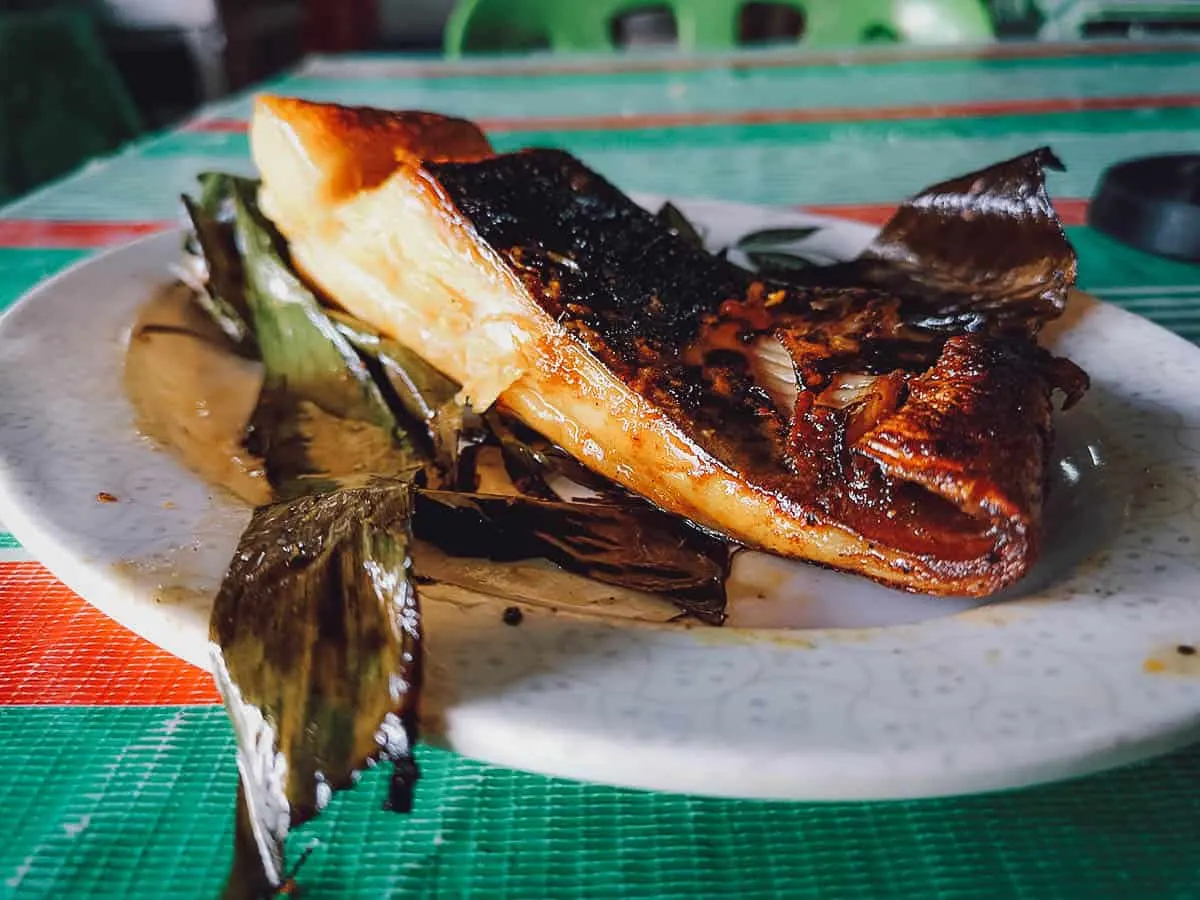
20. Peranakan Cuisine
Peranakan cuisine or Nyonya cuisine refers to the food of the Peranakans. The Peranakans are an ethnic group comprised of the descendants of early Chinese migrants who settled in Penang, Malacca, Singapore, and Indonesia between the 15th and 17th centuries. They inter-married with local Malays and produced a fusion of cultures that manifested itself in many ways, including their food.
Chinese ingredients were used with local spices and cooking techniques to create Peranakan interpretations of Malay food that’s known to be tangy, aromatic, spicy, and herbal. If you enjoy food with bold flavors, then you’re going to love Peranakan cuisine.
For the best example of Peranakan food in Singapore, I suggest trying it at Candlenut. From what I understand, it’s the only Peranakan restaurant in the world that’s been awarded a Michelin Star. Definitely not your average food centre meal.
RECIPE: Classic Peranakan dishes
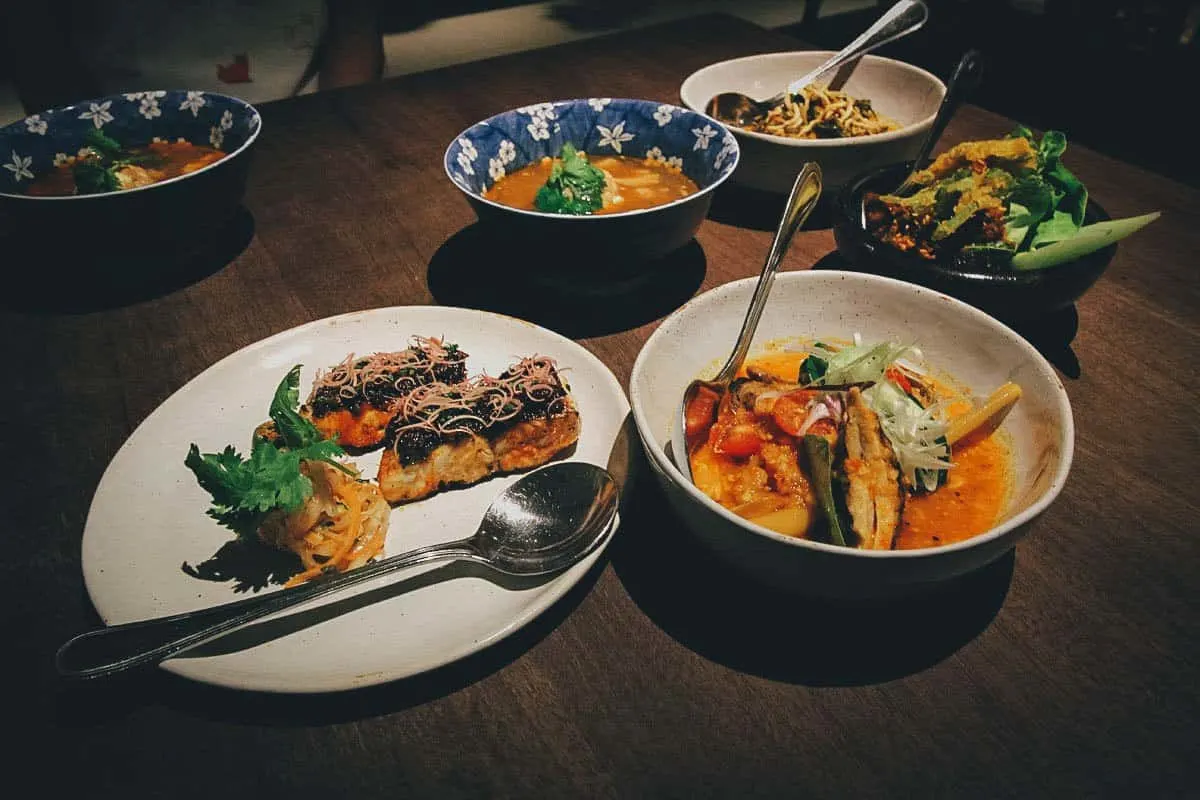
SINGAPOREAN NOODLE DISHES
21. Laksa
Laksa is one of my favorite dishes in Singapore. It’s a spicy Peranakan noodle soup consisting of thick wheat noodles or rice vermicelli made with chicken, prawn, or fish.
Available at almost any food centre, laksa is hugely popular in Singapore and in other parts of Asia. It exists in three basic types – curry, asam, and a combination of the two. Curry laksa is made with a rich and savory coconut milk base while asam laksa is made with a sour, tamarind-based (or gelugur) soup.
Depending on the ingredients, there are many sub-types of laksa but katong laksa is the type you’ll typically find in Singapore. It’s a type of curry laksa known for its gravy thickened with ground dried shrimp.
RECIPE: Curry laksa
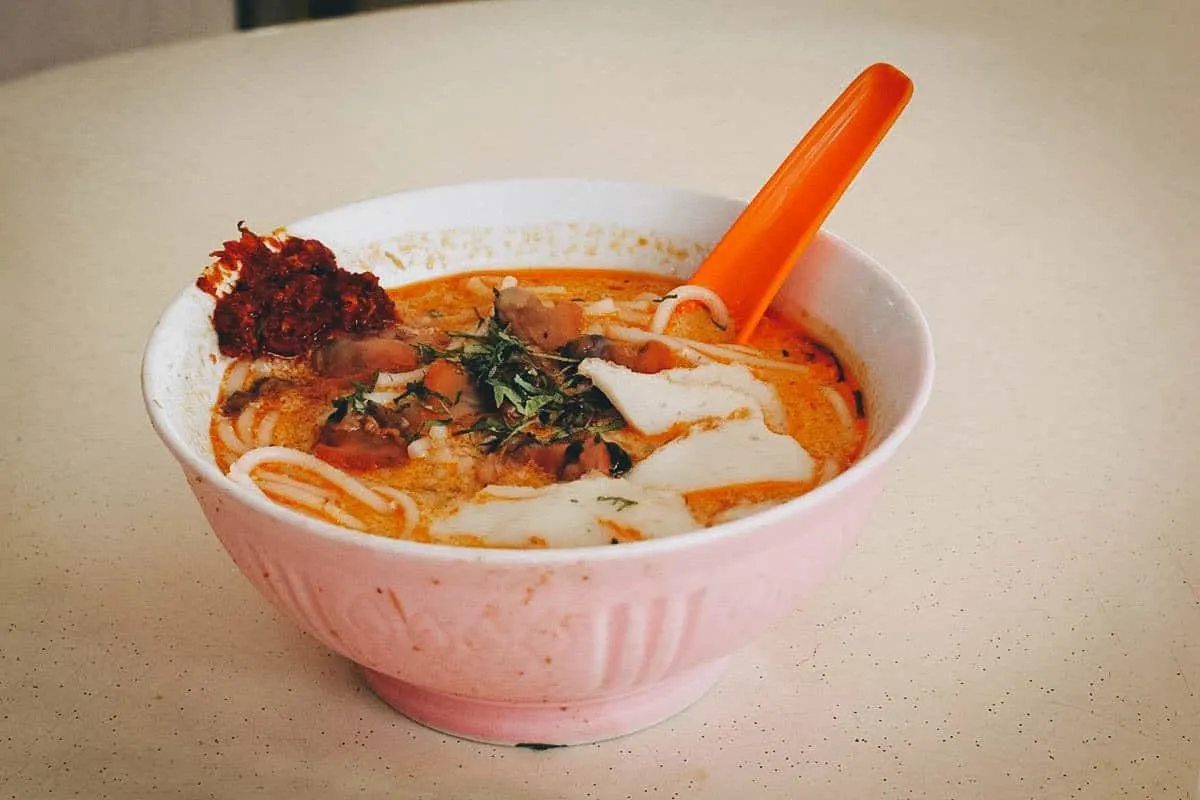
22. Bak Chor Mee
Bak chor mee is a popular hawker food in Singapore. It’s made with noodles tossed in vinegar and a myriad of ingredients like minced meat, pork slices, liver, mushrooms, meatballs, and bits of deep-fried lard.
Bak chor mee can come in soup or dry versions. Pictured below is the dry version from Hill Street Tai Hwa Pork Noodle, one of two Singapore hawker stalls awarded a Michelin Star in 2016. It’s absolutely delicious and something you need to eat in Singapore.
RECIPE: Bak chor mee
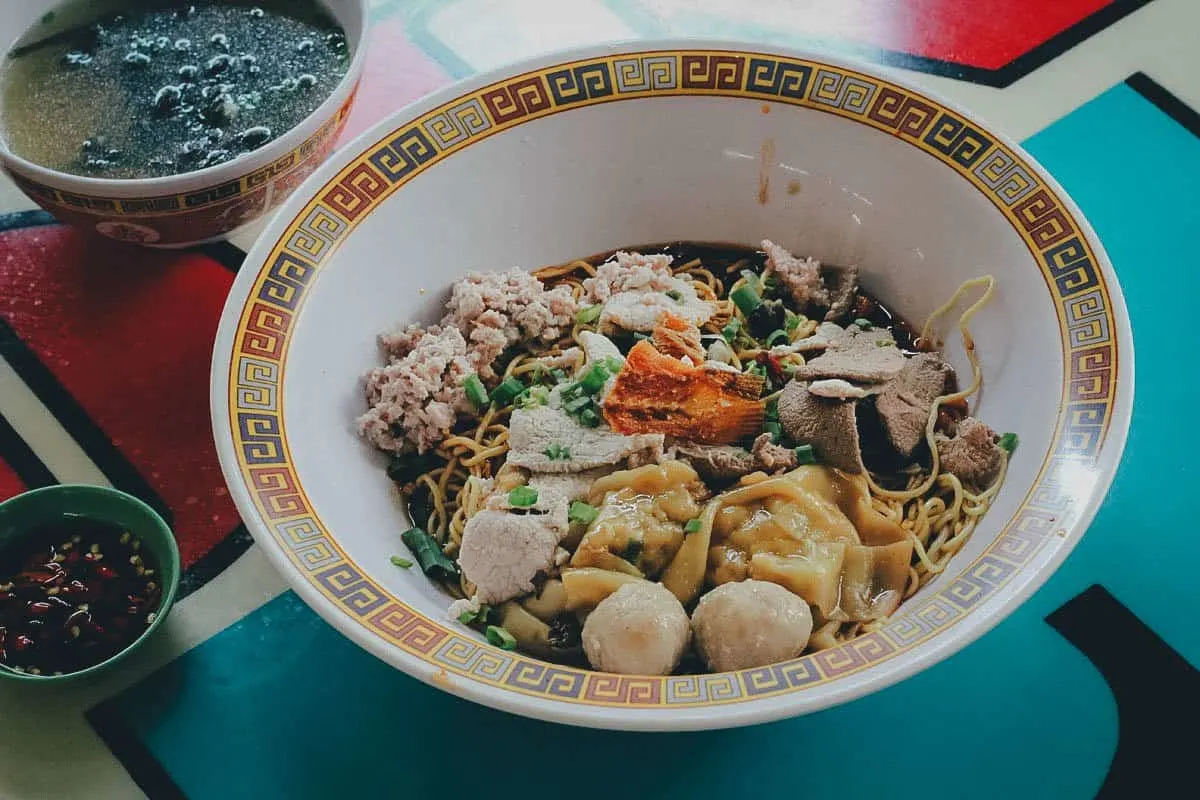
23. Prawn Mee / Hokkien Mee
Prawn mee refers to a popular soup made with egg noodles, rice noodles, prawn, and pork slices. From what I understand, it can come in a dry version as well known as hokkien mee.
I often saw the terms prawn mee and hokkien mee referring to what seemed like the same dish so I asked a Singaporean blogger to clarify. She told me that prawn mee is a soup dish while hokkien mee is a dry noodle dish. Unless I’m mistaken, I believe the ingredients for both are similar.
Pictured below is prawn mee. It’s known for its dark and spicy broth flavored with prawn heads, dried shrimp, white pepper, garlic, and other spices. It’s topped with fried shallots and spring onions and typically served with chopped red chilis in a light soy sauce with lime.
We haven’t tried it but hokkien mee is made by sir-frying the rice noodles with egg, slices of pork, prawn, and squid. It’s garnished with vegetables, bits of chicken lard, sambal, and lime.
RECIPE: Prawn mee
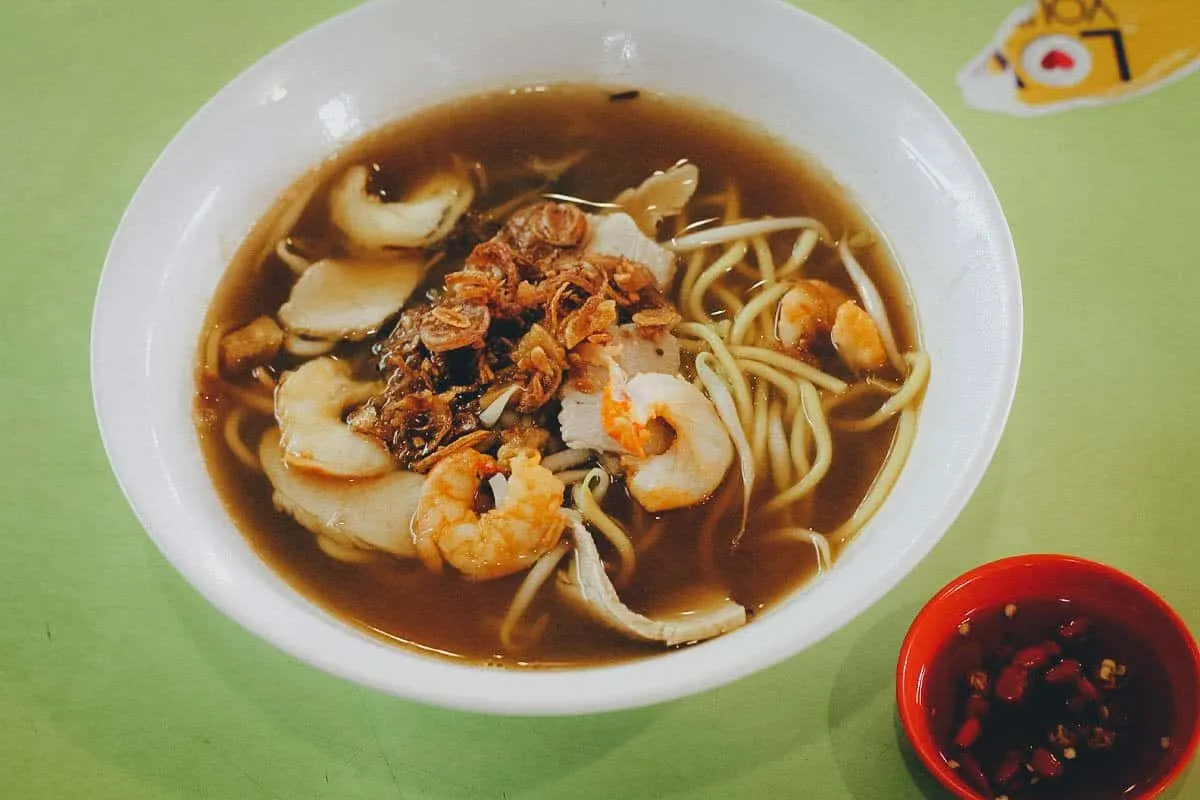
24. Char Kway Teow
Char kway teow is one of the most popular dishes to eat in Singapore. It refers to a stir-fried noodle dish made with flat rice noodles cooked over high heat.
To make char kway teow, flat rice noodles are stir-fried in pork fat with light and dark soy sauce, chili, and a slew of other ingredients like belachan (shrimp paste), prawn, blood cockles, Chinese sausage, sliced fish cake, and bean sprouts.
Like nasi lemak, char kway teow is a cheap and delicious dish that’s often eaten for breakfast and sold at many hawker centres in Singapore. Blood cockles and prawns are standard ingredients while more expensive versions can be made with other types of seafood like cuttlefish, squid, and lobster.
As irresistible as char kway teow is, this stir-fried noodle dish has a reputation for being unhealthy due to its high saturated fat content so it’s best to stop after one plate. Or two.
RECIPE: Char kway teow
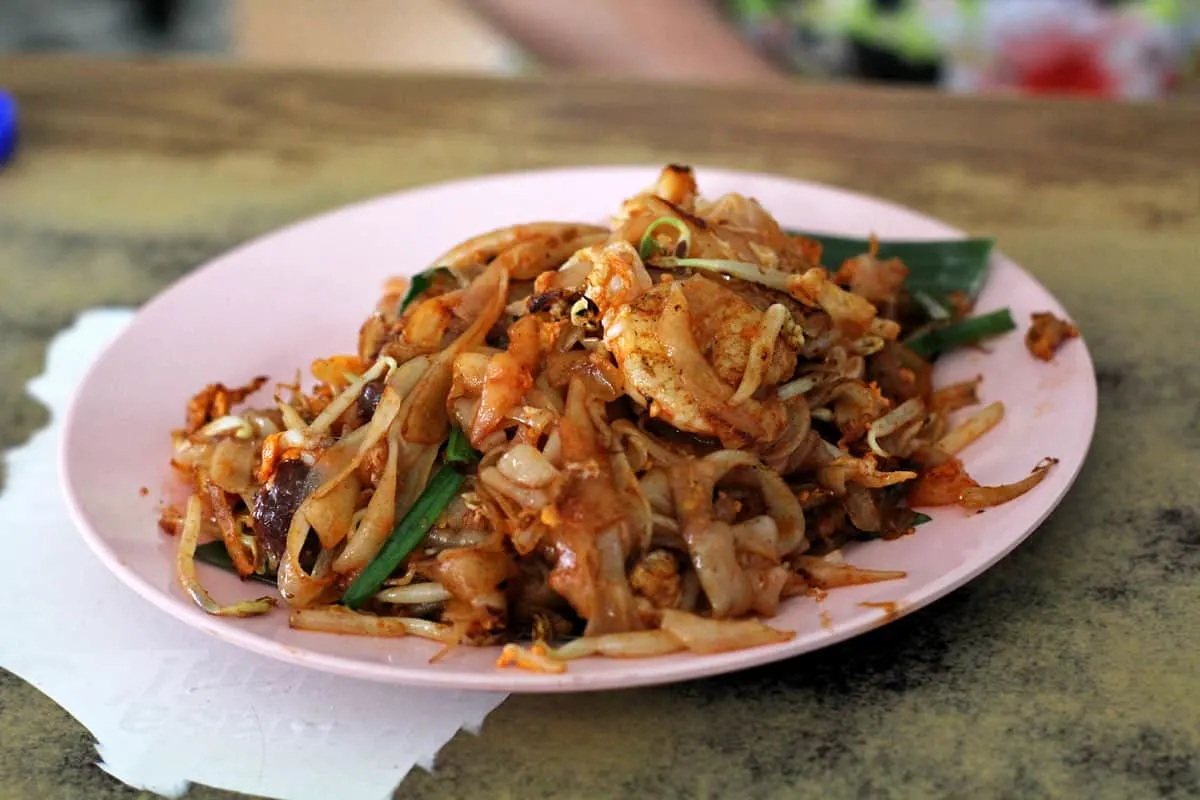
25. Crab Bee Hoon
Like chii crab, crab bee hoon is considered a true Singaporean invention. It refers to a dish made with whole mud crab and bee hoon (rice vermicelli).
Crab bee hoon is available in soup or dry versions. The soup version is served with a milky broth in a claypot while the dry version (pictured below) is prepared by stir-frying the noodles in a wok before braising it in broth.
The crab is usually the star but in this dish, it’s the bee hoon. Vermicelli noodles do an excellent job in soaking up all that sweet and seafood-y crab flavor.
RECIPE: Crab bee hoon
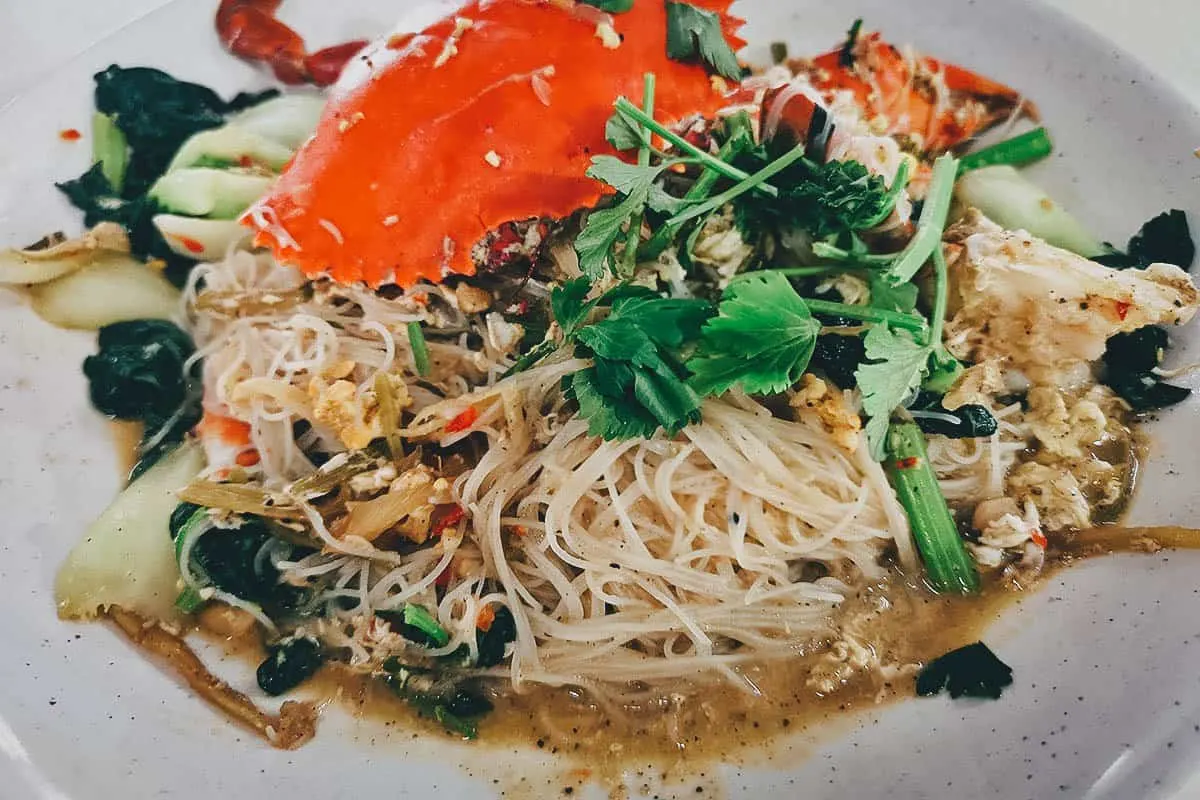
26. Mee Rebus
Mee rebus means “boiled noodles” and refers to a noodle soup dish popular in Singapore, Malaysia, and Indonesia. It consists of egg noodles served in a spicy and slightly sweet curry-like gravy.
The brown gravy is made with a slew of ingredients like shrimp or tauchu (preserved fermented yellow soybeans) broth, shallots, lemongrass, galangal, kaffir lime leaf, and corn starch as its thickening agent.
Mee rebus is typically garnished with a hard boiled egg, dried shrimp, boiled potato, fried shallots, bean sprouts, and other ingredients.
RECIPE: Mee rebus
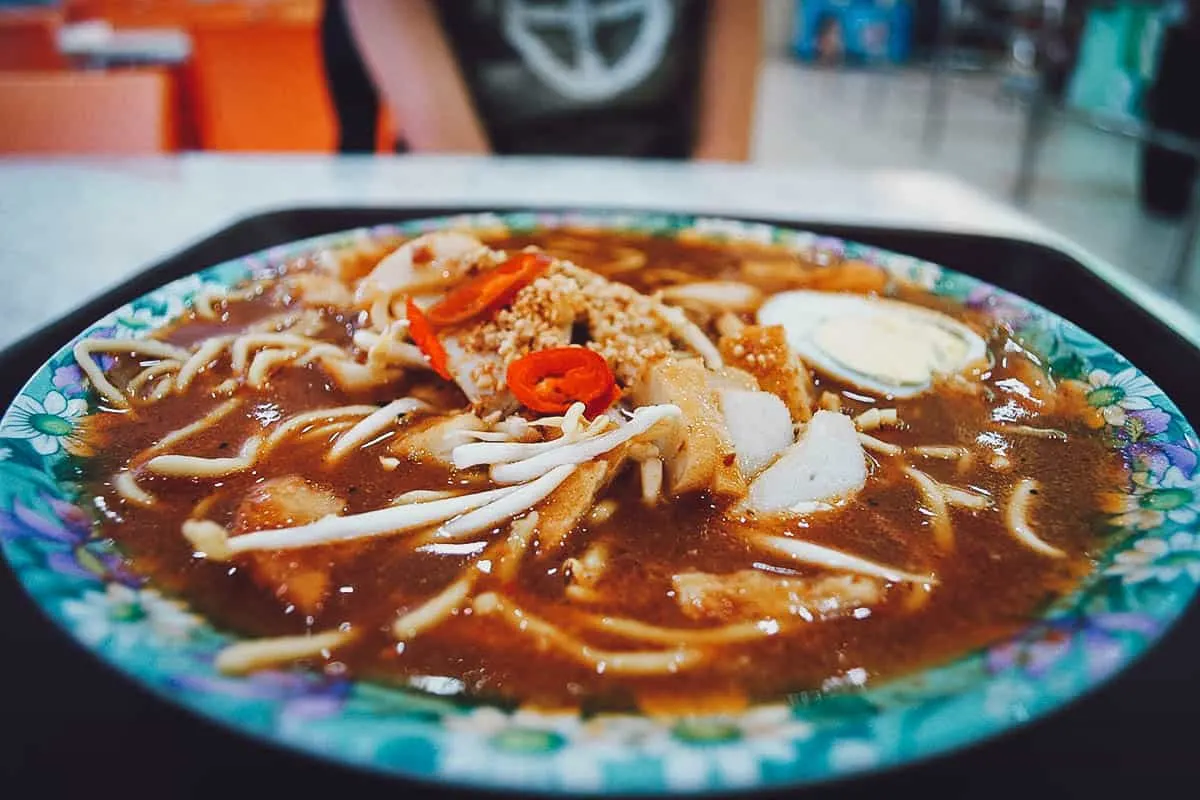
“Mee Rebus – Food Garden, LCCT RM5” by Alpha, used under CC BY-SA 2.0 / Processed in Photoshop and Lightroom
SINGAPOREAN RICE DISHES
27. Nasi Lemak
Nasi lemak refers to a beloved Malay rice dish consisting of fragrant rice cooked in coconut milk and pandan leaf. It’s a popular breakfast food in Singapore and in other countries like Malaysia where it’s considered a national dish.
Like kaya toast, nasi lemak is typically eaten for breakfast though it can be enjoyed at any time of the day. It’s served with a spicy sambal and a variety of garnishes like fresh cucumber slices, ikan bilis (small fried anchovies), roasted peanuts, and hard-boiled or fried egg.
When eaten for lunch or dinner, nasi lemak is usually accompanied by heavier proteins like ayam goreng (fried chicken), sambal sotong (cuttlefish in chili), or small fried fish.
Depending on where it’s from, nasi lemak can exist in varying forms but in Singapore, it’s commonly found in two variations – the Singaporean Malay and Singaporean Chinese versions.
The Singaporean Malay version of nasi lemak is made with a sweeter, less spicy sambal and served with ikan bilis, peanuts, and an omelette or fried egg. Singaporean Chinese nasi lemak on the other hand, is served with a wider variety of sides like deep-fried drumstick, fried chicken franks, sliced fish cake, curried vegetables, and tongsan luncheon meat.
Like laksa and chicken rice, nasi lemak is one of my favorite dishes so the version doesn’t really matter for me. It’s delicious any which way and definitely one of my favorite things to eat in Singapore.
RECIPE: Nasi lemak
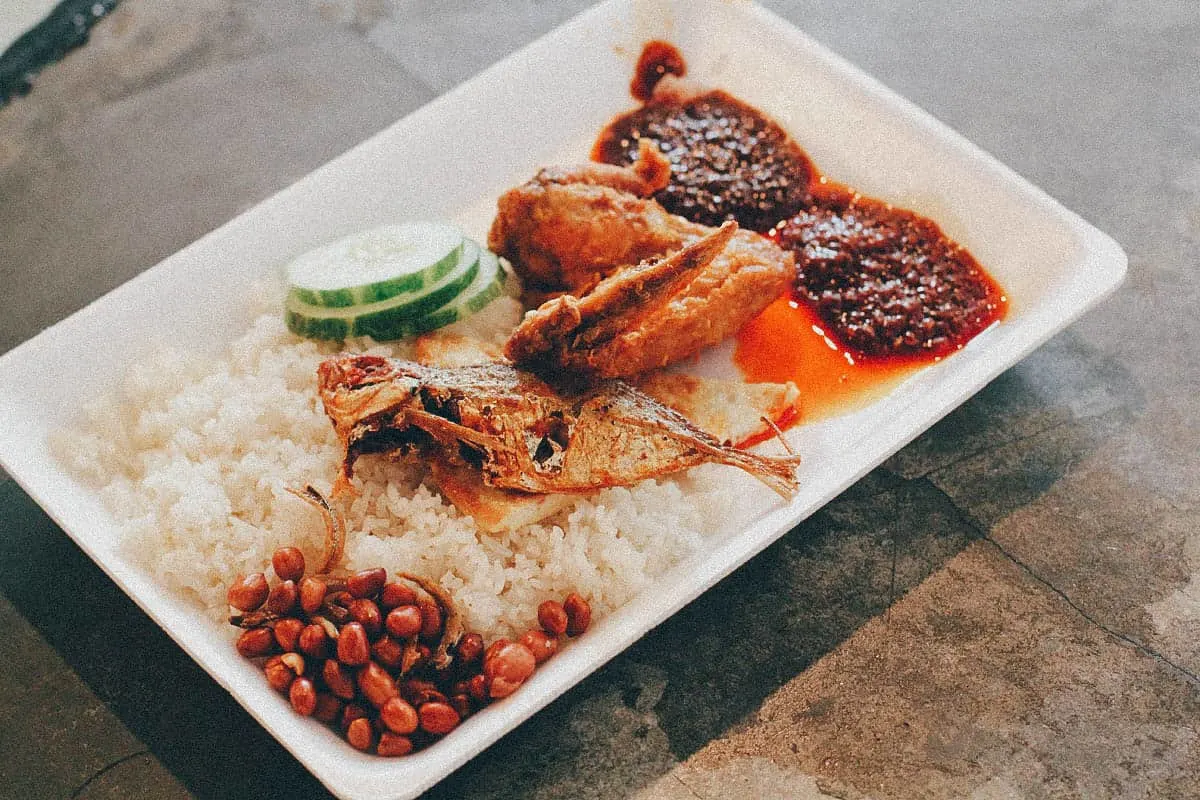
28. Hainanese Chicken Rice
Hainanese chicken rice is one of the most important Singaporean foods and considered by many to be a national dish. It refers to a rice dish of poached chicken and seasoned rice served with sliced cucumber and chilli sauce.
After their British employers were forced out of Singapore during the Japanese occupation, Hainanese servant-class immigrants created chicken rice as an alternate source of income. They opened the first chicken rice restaurants in the early 1940s and the dish has since become one of the most popular hawker center foods in Singapore.
To make Hainanese chicken rice, whole chickens are poached at sub-boiling temperatures. The resulting chicken stock is skimmed off while some of the fat and liquid, along with ginger and garlic, are used to cook the rice. The result is an oily, flavorful rice sometimes referred to as “oily rice”.
Hainanese chicken rice looks colorless and bland but it’s actually very tasty. It’s usually served with a trio of dipping sauces that include chili sauce, kecap manis (sweet soy sauce), and pureed ginger.
Personally, Hainanese chicken rice is one of my absolute favorite dishes and something I need to have on every return trip to Singapore.
RECIPE: Hainanese chicken rice
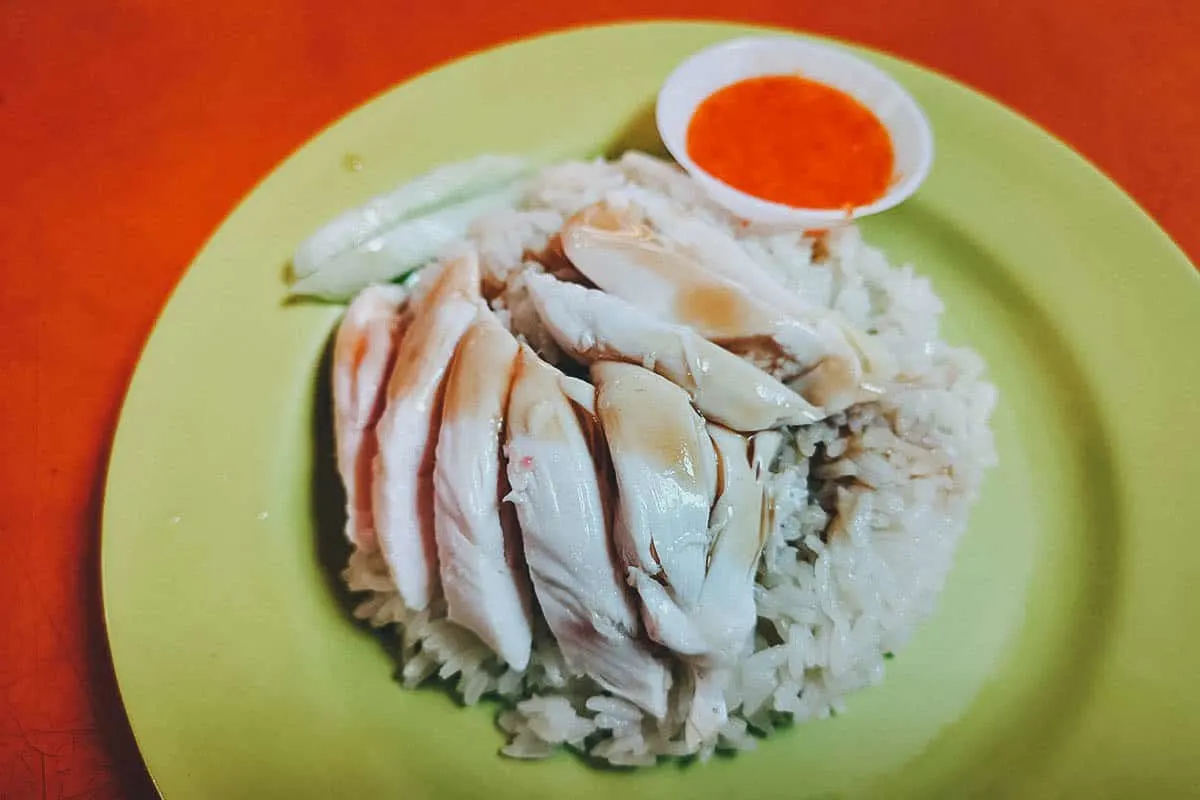
29. Claypot Rice
Claypot rice refers to a traditional southern Chinese rice dish that’s become a popular food in Singapore, Malaysia, and Hong Kong.
To prepare, rice is pre-soaked and sometimes par-cooked before being finished in a claypot with a mix of ingredients that help impart flavor to the rice. It can be made with any number of ingredients with some of the most common being chicken, salted fish, Chinese sausage, and vegetables.
Slow-cooked over a charcoal stove, the rice develops a scorched rice crust similar to socarrat in Spanish paella or Korean dolsot bibimbap.
RECIPE: Claypot chicken rice
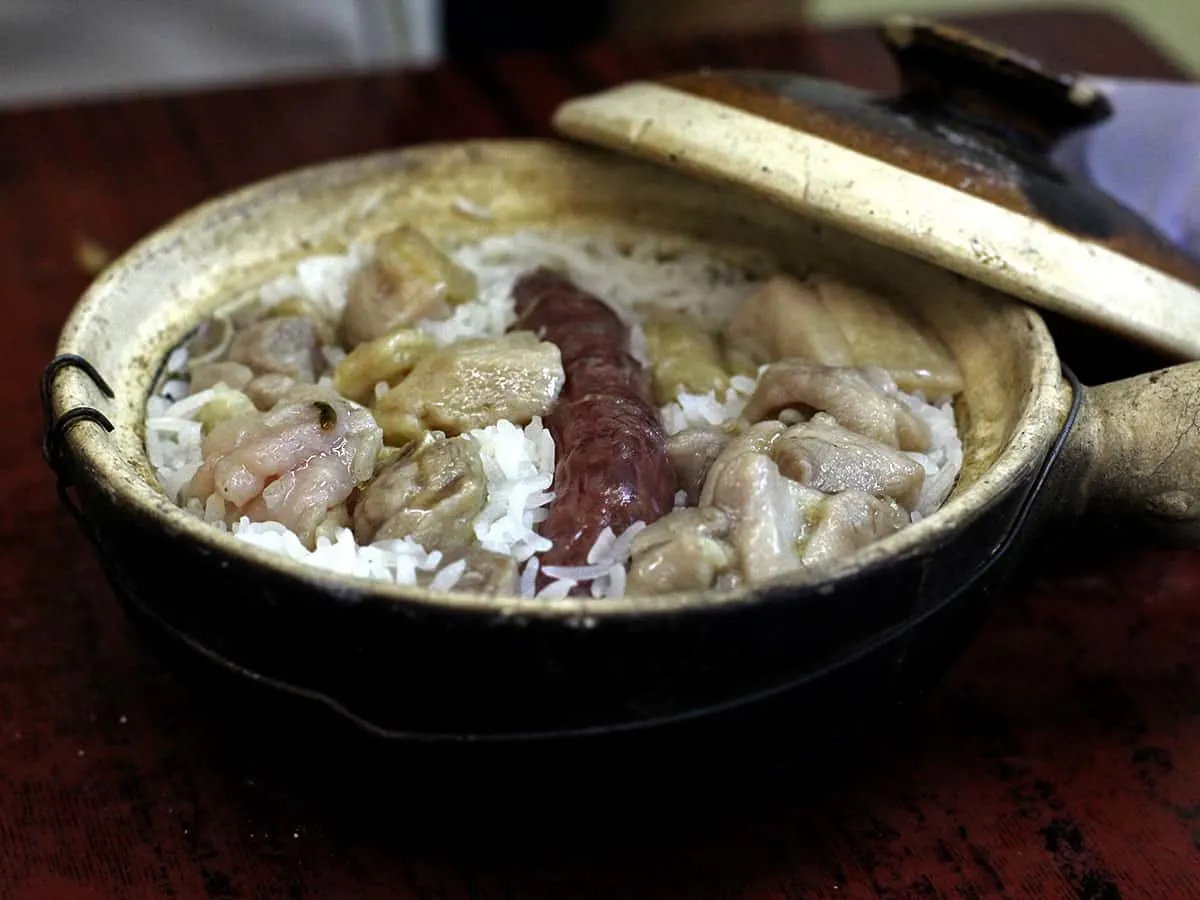
30. Duck Rice
As its name suggests, duck rice is a dish made with roasted or braised duck served with steamed rice. It’s popular at hawker stalls in Singapore and in other parts of Asia.
The braised duck is usually cooked with yam and shrimp and served with a heavy dark sauce over rice. It can be served on its own or with other ingredients like braised hard-boiled eggs, preserved salted vegetables, and hard beancurd.
RECIPE: Teochew braised duck
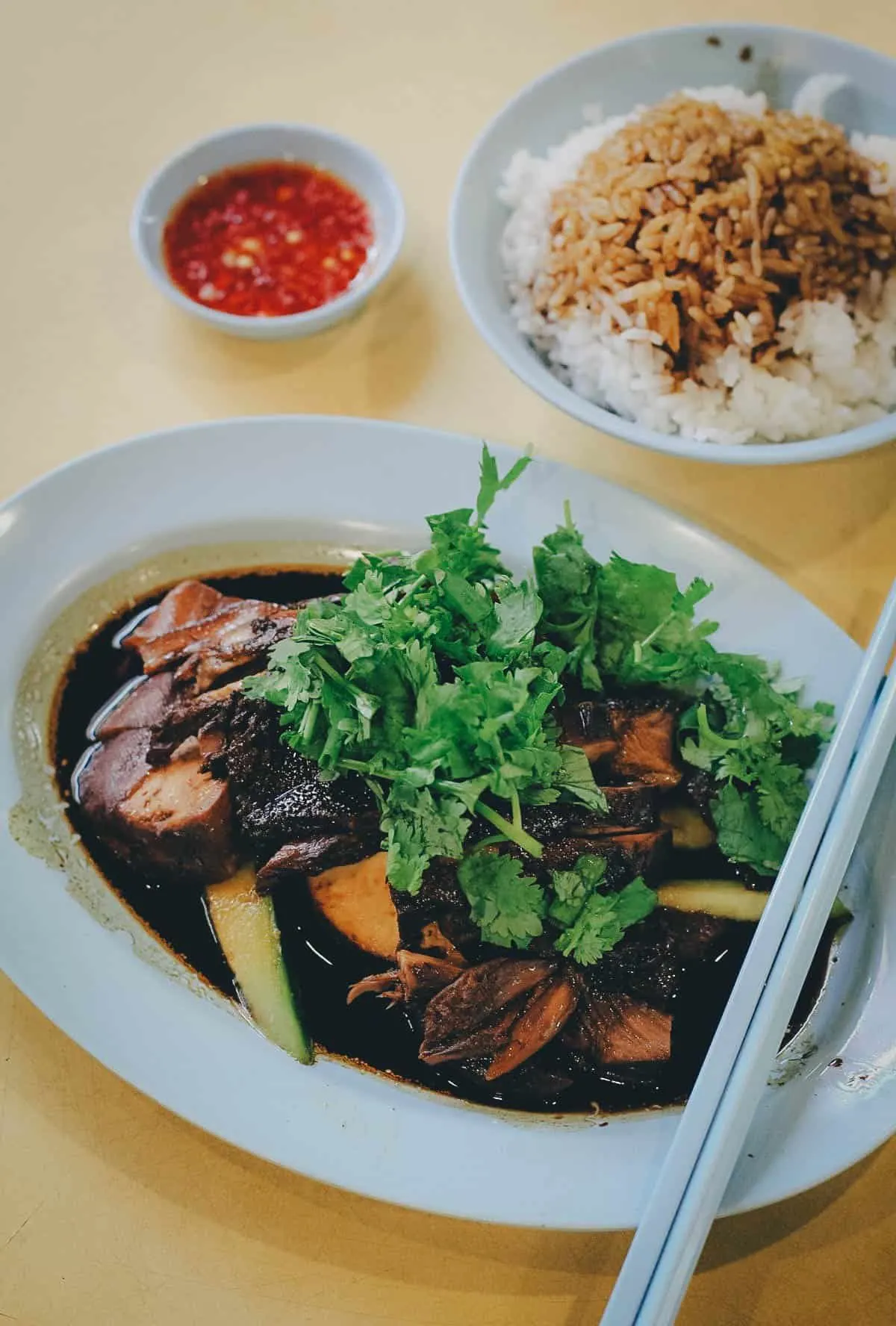
SINGAPOREAN DESSERTS / DRINKS
31. Durian
Durian is a fruit that many people love to hate. They can’t get past the smell which is a shame because it’s absolutely delicious. For me, it’s one of the best and most unique-tasting fruits in the world.
Known as the “king of fruits”, durian is popular in Singapore and in many parts of Asia. It’s known for its strong odor and spiny, thorn-covered rind. Because of its odor, durian is a polarizing fruit that elicits a range of reactions from deep fondness to intense disgust.
People who can’t stand the odor describe it as being similar to the smell of raw sewage or dirty gym socks. I happen to love durian so I don’t mind its smell. It does have a strong and unusual odor but in my opinion, it’s a small price to pay for a creamy and custardy fruit that tastes similar to almonds.
Because of its strong and lingering odor, durian is banned in many public places in Singapore, including the MRT.
Also know that not all durian are created equal. Some are more prized (and thus pricier) than others with some of the most sought after brands being Mao Shan Wang, D24, and Red Prawn. Check out this article for a list of the best durian in Singapore.
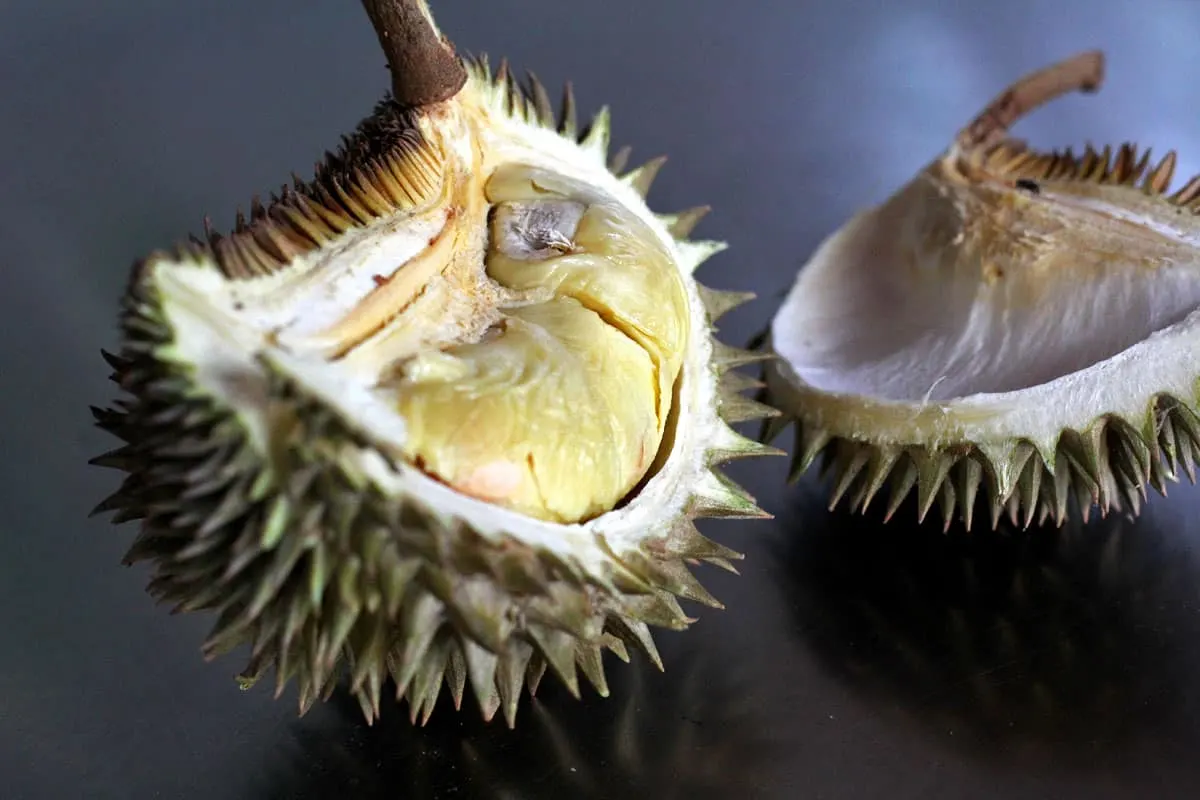
32. Kueh
Kueh refers to a family of bite-sized snacks or desserts popular throughout the region. It’s a broad term used to describe a wide spectrum of food products like cakes, dumplings, pudding, or pastries usually made with rice or glutinous rice. Most are sweet but some, like chwee kueh, can be savory.
Pictured below is kueh lopis, a type of kueh made with glutinous rice, gula melaka, and shredded coconut.
RECIPE: Kueh lapis
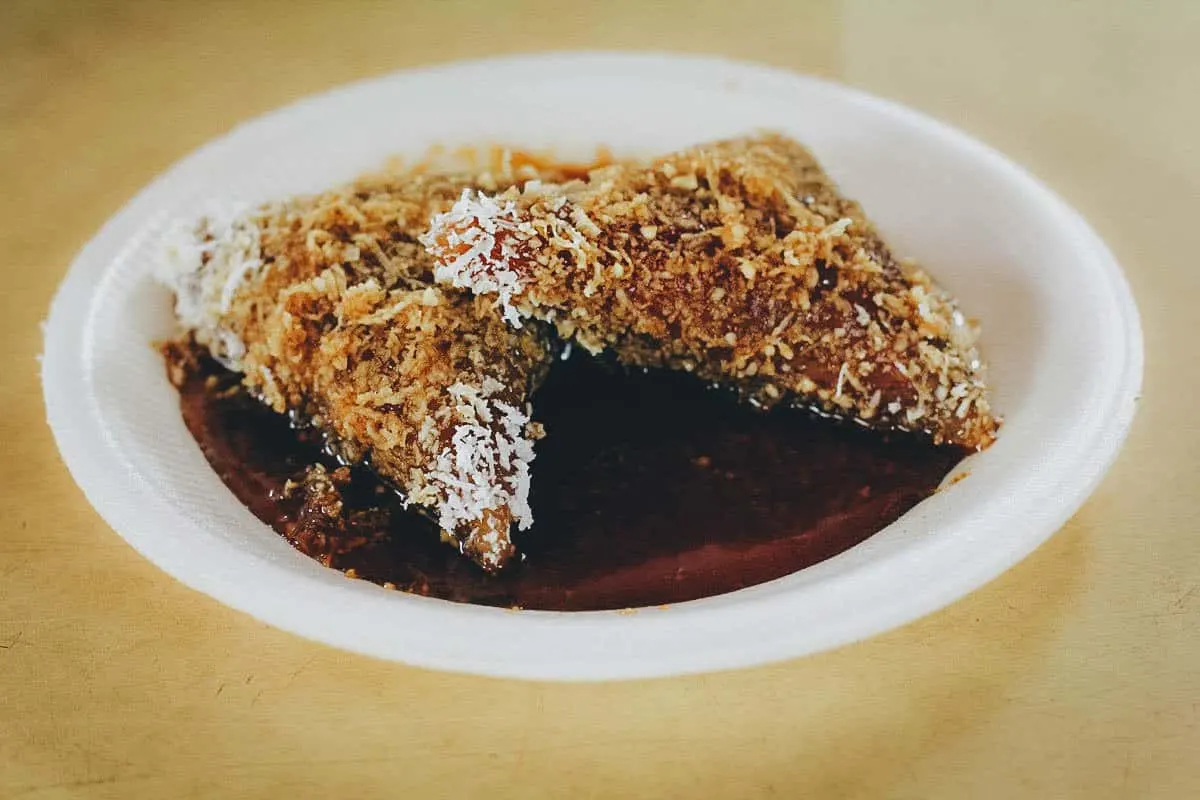
If I remember correctly, the green and white kueh below is kueh salat while the other one is kueh bingka jagung. Kueh salat is made with pandan and tapioca while kueh bingka jagung is made with corn pudding and palm sugar.
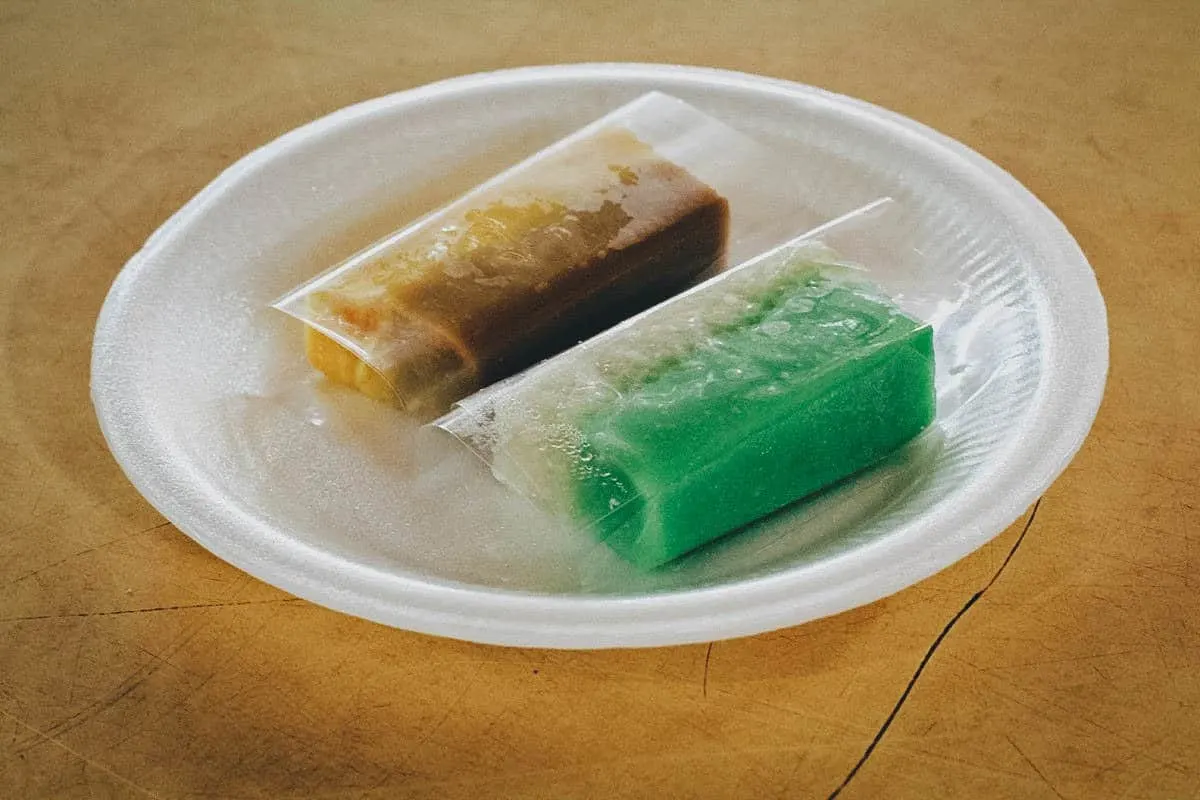
33. Cendol
Cendol refers to a shaved iced dessert made with strands of green rice flour jelly mixed with coconut milk and palm sugar syrup. It’s a popular dessert in Singapore and in many parts of Southeast Asia.
Depending on where it’s from, other ingredients can also be added like red azuki bean, diced jackfruit, glutinous rice, sweet corn, and durian. In Singapore, cendol is typically made with sweetended red bean with the palm sugar poured over as a syrup.
RECIPE: Cendol
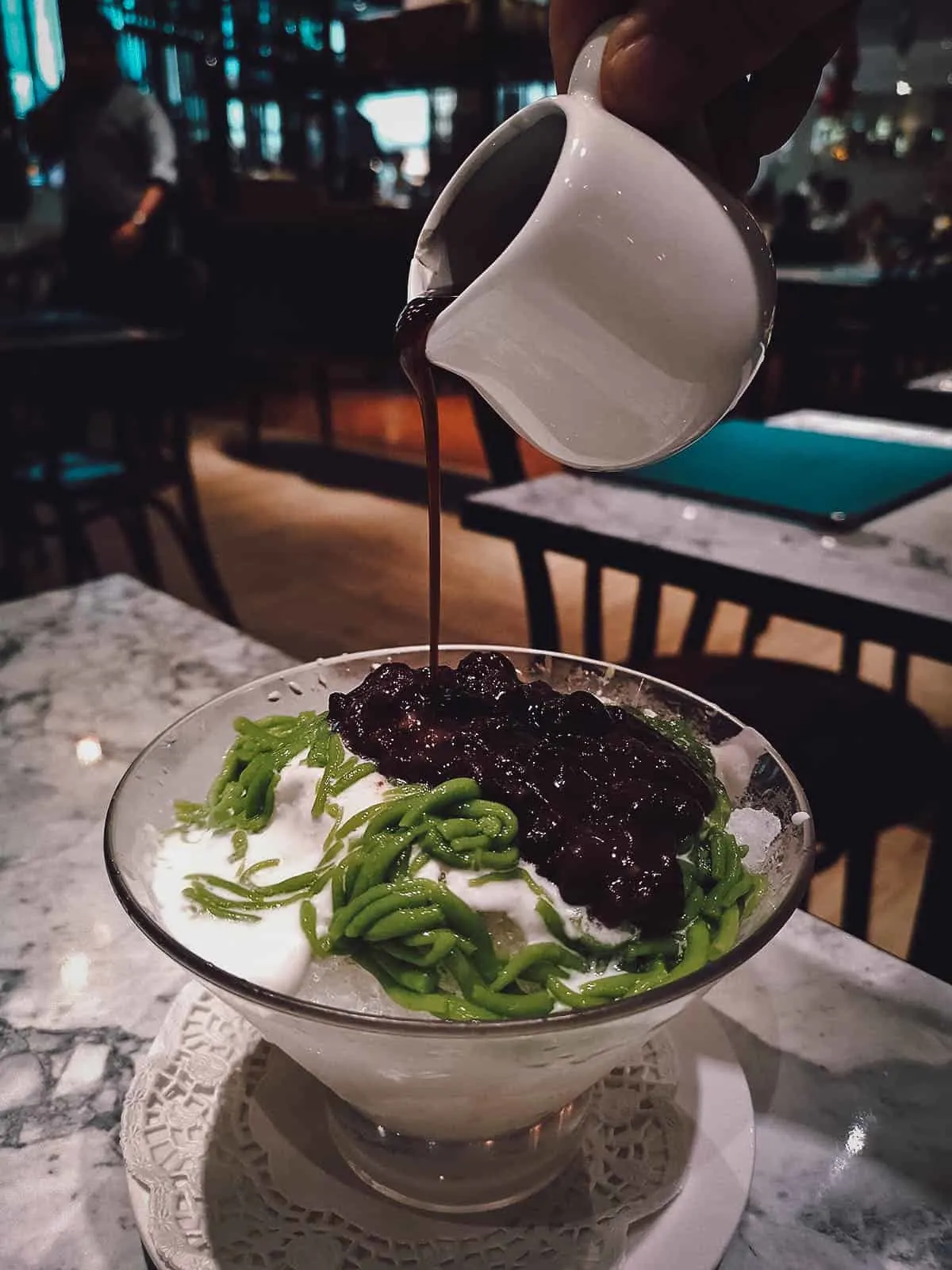
34. Ice Cream Sandwich
To many westerners, this may be the oddest entry in this Singapore food guide. Ice cream wrapped in a slice of white bread may be weird to some people but in some countries like Singapore and the Philippines, it’s an iconic snack.
You can have your choice of flavor like strawberry, vanilla, or durian wrapped in bread (either white or rainbow-colored) or between wafers. For the truest Singapore food experience, I suggest going with the ice cream sandwich made with bread.
RECIPE: Singaporean ice cream sandwich
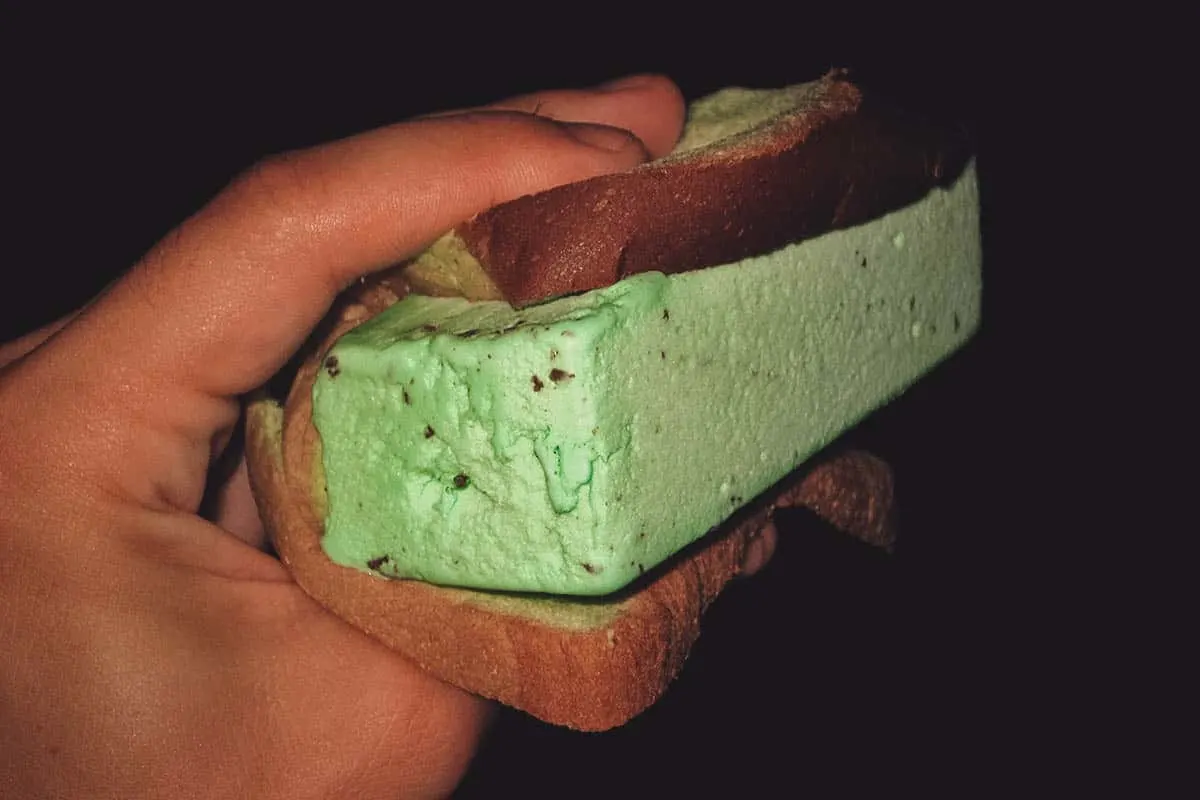
“IMG_4892” by Ken Masrhall, used under CC BY 2.0 / Processed in Photoshop and Lightroom
35. Teh Tarik
Teh tarik refers to a hot milk tea beverage popular in Singapore and in other Southeast Asian countries. Its name literally means “pulled tea” and is in reference to the way the tea is poured back and forth from a distance.
As you can see below, teh tarik vendors have mastered the art of “pulling” the tea without spilling a drop. They do this to aerate and mix the drink, as well as to cool it and improve its flavor.
Teh tarik is a sweet and rich milk tea drink that’s great to have after a heavy meal in Singapore.
RECIPE: Teh tarik
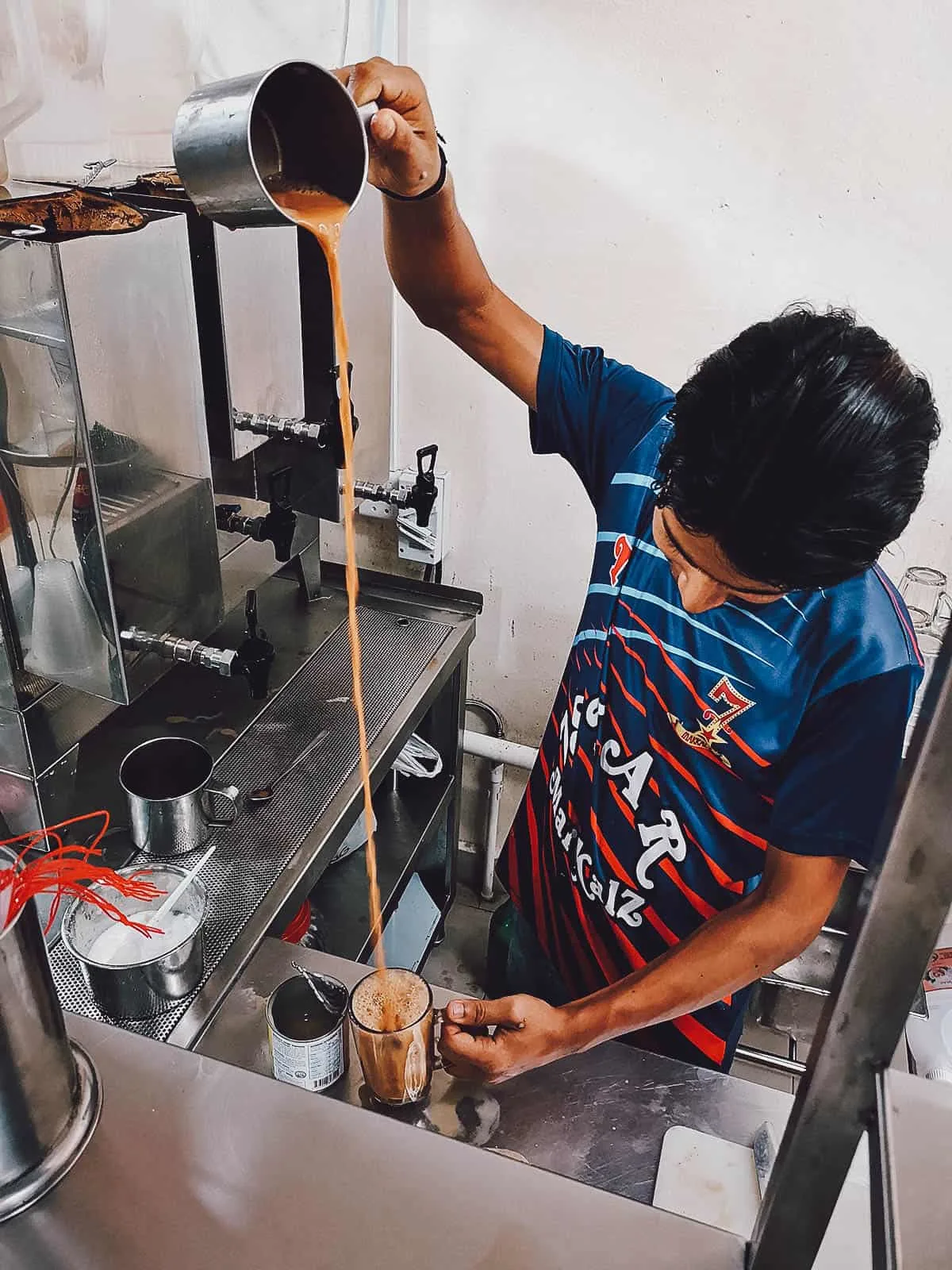
SINGAPORE FOOD TOURS
No one knows the food in Singapore better than a local. Singaporeans are some of the most food-obsessed people in the world so what better way to experience Singapore’s food culture than by going on a food tour? I went on a food tour in Singapore and learned about a few interesting Singaporean dishes I had never heard of before.
It’s fun visiting hawker centres on your own but if you’re pressed for time, then going on a Singapore food tour with a knowledgeable local is one of the best and easiest ways of experiencing the cuisine. Check out Get Your Guide for list of food tours in Singapore.
SINGAPORE COOKING CLASSES
We haven’t done it in Singapore but taking cooking classes is one of our favorite things to do on trips. The way I see it, it’s one of the best ways to learn about an unfamiliar cuisine. It’s like looking under the cuisine’s hood. If you’d like a more in-depth look at Singaporean cuisine when you visit, then check out Cookly for a list of cooking classes in Singapore.
FINAL THOUGHTS ON SINGAPOREAN CUISINE
It’s funny, the more I explore a country’s cuisine, the more I understand how much more there is to learn. We’ve been to Singapore many times but every visit always leaves me wanting for more.
As fond as we are of Singaporean cuisine, we’ll definitely be back to refine and build upon this Singapore food guide. Like Japan and Vietnam, Singapore is one of our favorite countries for food and a place we will never grow tired of. It never ceases to amaze how much good local food there is to be had in a country as small as Singapore.
If you love Singaporean food and have recommendations on which dishes to try and which hawker centres to visit on our next trip to Singapore, then please let us know in the comments below. We’d love to hear from you.
Thanks for reading and we hope this Singapore food guide leads you to many shiok meals in the Lion City!
Disclosure
Some of the links in this article are affiliate links, meaning we’ll get a small commission if you make a booking at no extra cost to you. We only recommend products and services that we use ourselves and firmly believe in. We really appreciate your support as this helps us make more of these free travel guides. Thank you!


Danial Roslan
Thursday 29th of April 2021
Kaya is not Hainanese origin but from Malay origin. Its original name is srikaya which when literally translated is "radiantly rich" referring to its creamy texture and taste. Kaya is the basis for many malay kuehs like puteri salat and kueh talam.
JB & Renée
Monday 3rd of May 2021
Thanks for the information Danial. That's very interesting indeed.
Caro
Friday 12th of March 2021
You've barely touched the tip of the iceberg on the food in Singapore! Also, Malaysian usually refers to the country, whereas Malay refers to the indigenous people and their cuisine. You need to look for the Malay version of chicken rice, it's not to be missed! Also western style cakes in Singapore! Blackforest cake was a favorite. I could go on....
JB & Renée
Friday 12th of March 2021
Hi Caro, all these food guides barely touch the tip to be honest. We aim for a maximum of 45 and it's impossible to represent an entire cuisine based on that, so we stick to our personal favorites. :) And thanks for the tip about the chicken rice! We'll keep that in mind on our next trip to Singapore. Cheers.
myline
Friday 20th of November 2020
It tastes delicious. I hope I can travel there someday to taste these amazing foods!
JB & Renée
Saturday 28th of November 2020
@myline: Go for it! :)